Grouses are fascinating ground-dwelling birds belonging to the family Phasianidae, known for their elaborate courtship displays, robust bodies, and adaptation to a wide range of habitats from forests to alpine regions. With over 30 distinct species worldwide, these birds play essential ecological roles, from seed dispersal to controlling insect populations. In this guide, we’ll explore the physical characteristics, behaviors, habitats, and unique traits of 30 types of grouses, helping birdwatchers, wildlife enthusiasts, and beginners identify these remarkable birds in the wild. This comprehensive review offers detailed descriptions while remaining beginner-friendly and SEO-optimized.
1. Willow Ptarmigan (Lagopus lagopus)
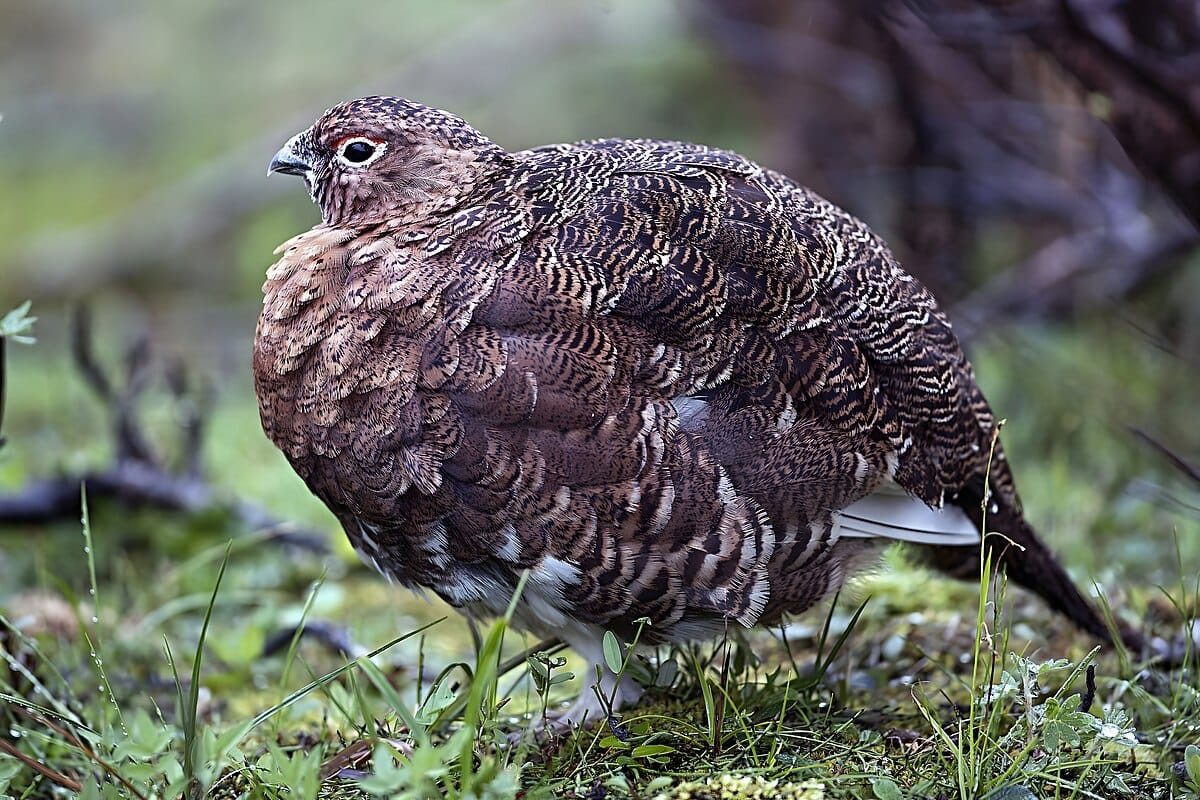
The Willow Ptarmigan is a cold-adapted grouse species found across the Arctic tundra of North America and Eurasia. It exhibits seasonal plumage changes: brown in summer for camouflage in tundra shrubs, and white in winter to blend with snow. Adults typically measure 14–17 inches in length, with a wingspan of up to 26 inches.
Primarily herbivorous, Willow Ptarmigans feed on leaves, buds, and berries. During winter, they may eat twigs and catkins when vegetation is scarce. These birds are well-adapted to harsh climates, with feathered feet that act as snowshoes and provide insulation against freezing temperatures.
During the breeding season, males perform impressive display rituals, including vocal calls, wing flapping, and puffing up feathers to attract females. Females build shallow nests on the ground, often hidden under shrubs, and lay 6–12 eggs. Predators include foxes, raptors, and humans.
Observing Willow Ptarmigans provides insight into evolutionary adaptations to extreme environments. Their seasonal camouflage, unique vocalizations, and foraging behaviors make them a fascinating species for ornithologists and birdwatchers alike.
2. Rock Ptarmigan (Lagopus muta)
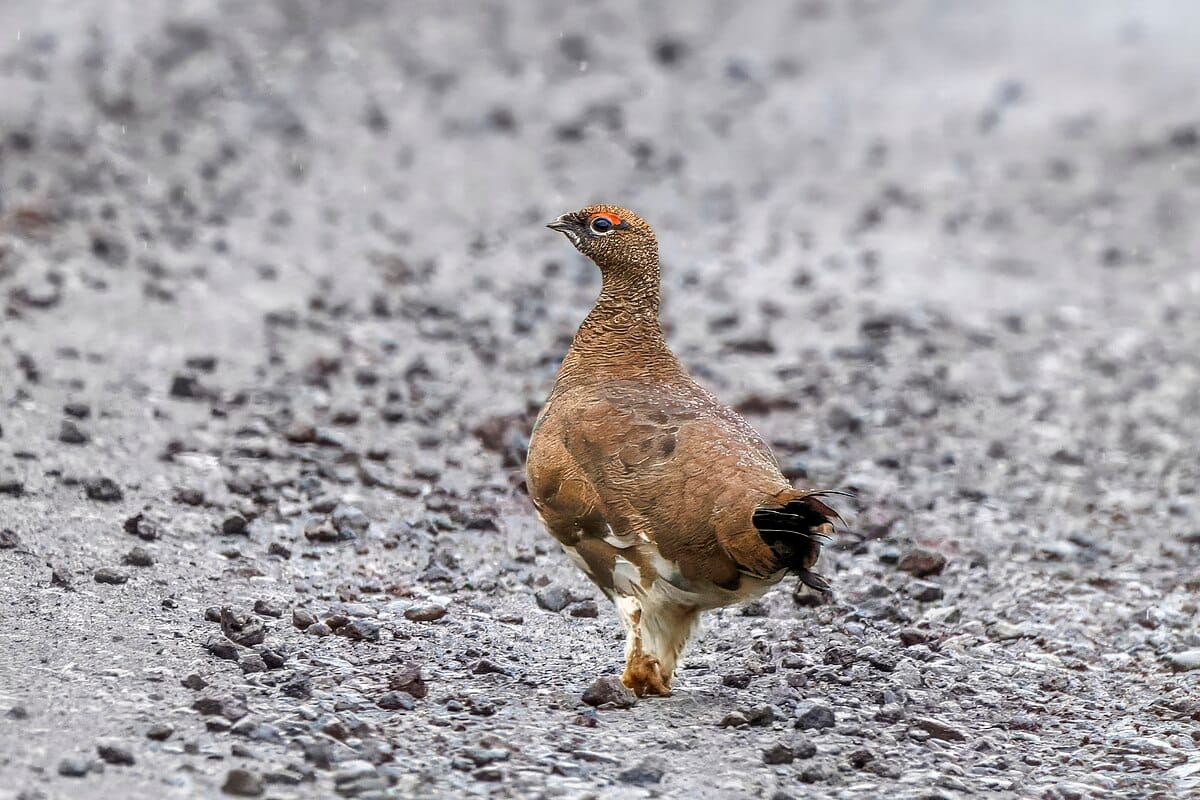
The Rock Ptarmigan is closely related to the Willow Ptarmigan but prefers mountainous regions and Arctic rocky terrains. Adults are 13–15 inches long, with males larger than females. Like their willow relatives, they exhibit seasonal plumage changes, with cryptic white winter feathers and mottled brown summer plumage.
Rock Ptarmigans are herbivores, feeding mainly on leaves, buds, flowers, and berries. In winter, they consume woody plants and lichens. Their behavior is highly adapted to cold, snowy environments; feathered feet provide insulation and traction on icy surfaces.
During breeding season, males display elaborate strutting, wing flapping, and vocalizations to attract females. Females nest directly on the ground, camouflaging their eggs among rocks and vegetation. Predators include Arctic foxes, snowy owls, and humans.
Rock Ptarmigans are vital indicators of alpine ecosystem health. Their seasonal adaptations and resilience to harsh climates make them excellent examples of evolutionary success in extreme environments.
3. White-tailed Ptarmigan (Lagopus leucura)
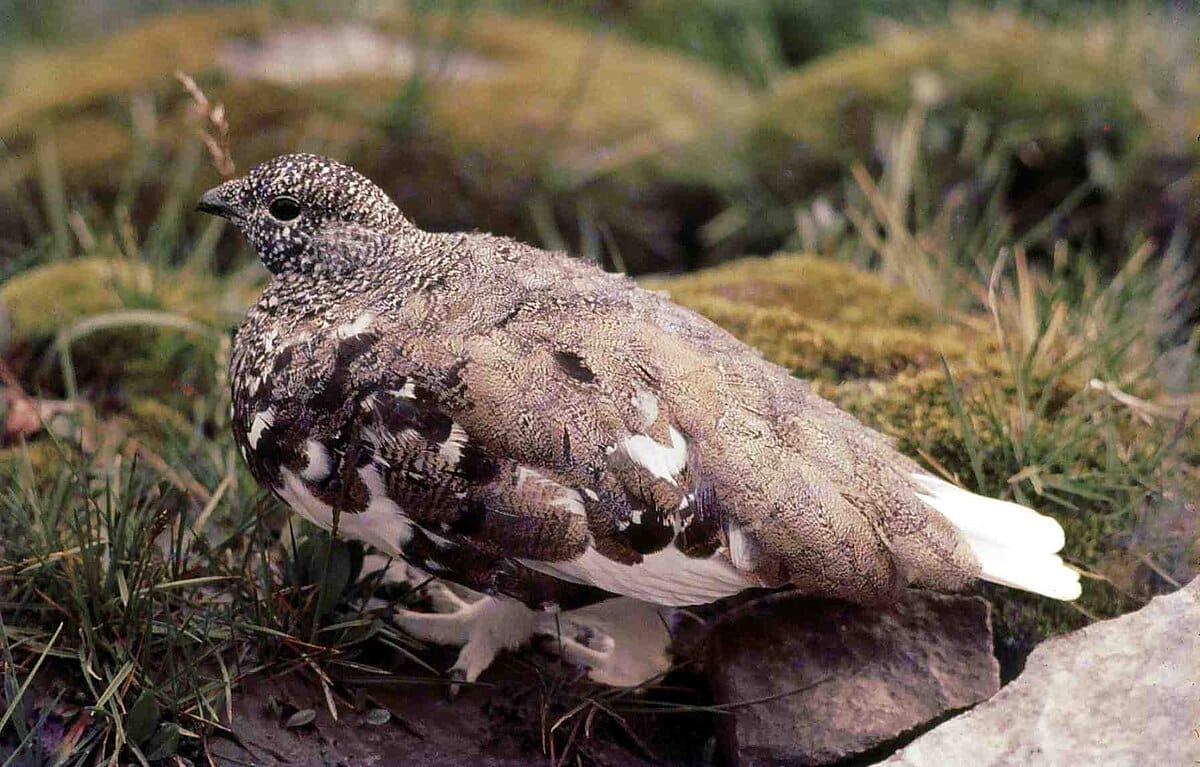
The White-tailed Ptarmigan is the smallest North American ptarmigan, measuring 12–14 inches in length. Native to high-altitude alpine zones in the Rocky Mountains, this species is distinguished by its white tail and seasonal plumage changes: brown in summer and white in winter.
Herbivorous in diet, White-tailed Ptarmigans feed on leaves, buds, and flowers in summer and twigs and willow catkins in winter. Their behavior and physiology are highly adapted to survive extreme cold, including feathered feet for warmth and traction.
During mating season, males perform courtship displays, including calling, wing flapping, and aerial displays. Nests are shallow depressions on the ground, often protected by rocks or vegetation. Predators include golden eagles, foxes, and weasels.
Studying White-tailed Ptarmigans offers insights into alpine adaptations, seasonal camouflage, and the challenges of surviving in high-altitude environments. Birdwatchers prize this species for its elusive nature and remarkable resilience.
4. Black Grouse (Lyrurus tetrix)
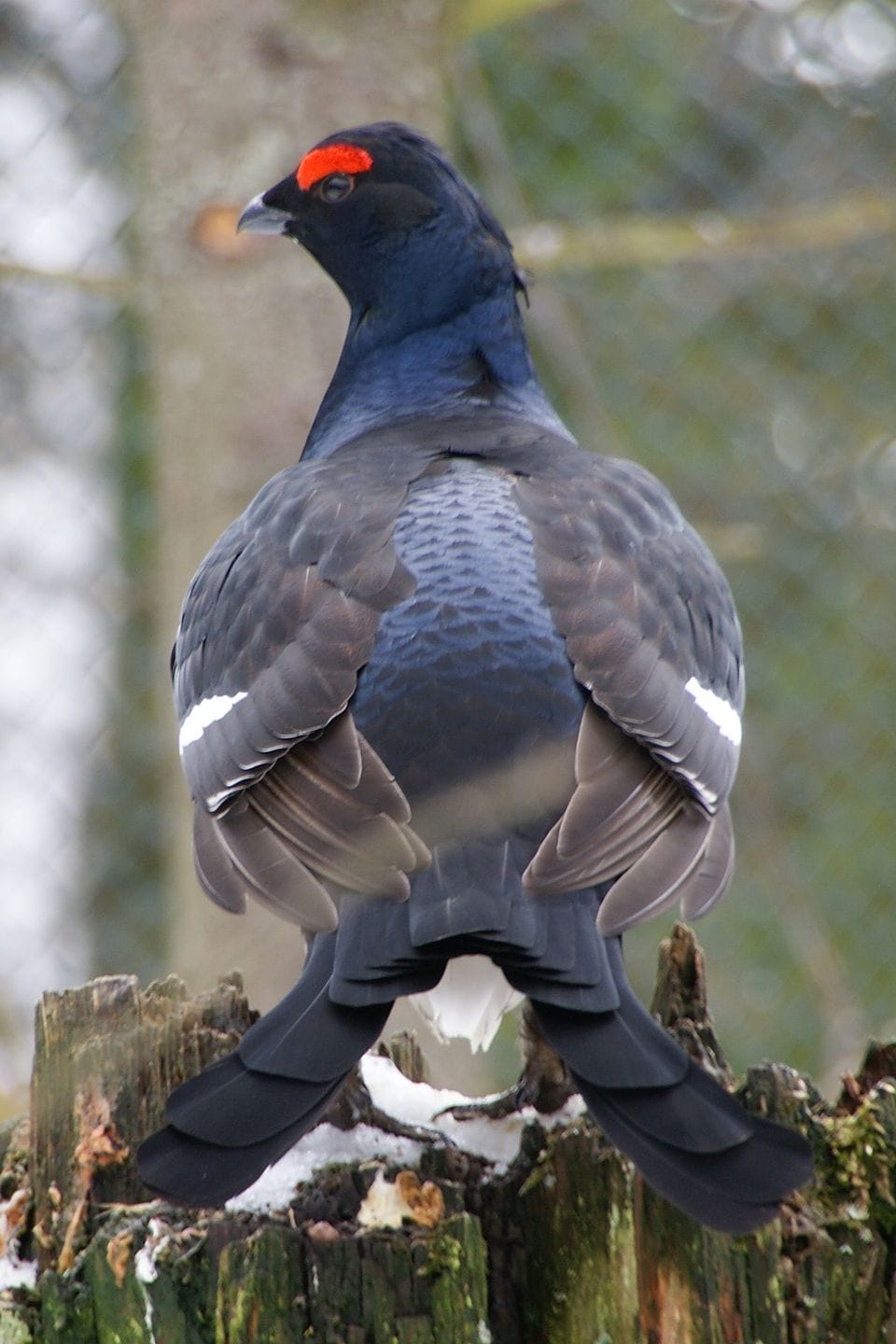
The Black Grouse is a striking bird native to Eurasian forests and moorlands. Adult males are distinguished by their glossy black plumage, red eye combs, and distinctive lyre-shaped tail feathers. Females are mottled brown for camouflage. Males weigh 1.2–1.5 kg, while females are lighter at 0.9–1 kg.
Black Grouse are omnivorous, feeding on leaves, shoots, berries, and insects. They inhabit mixed forests, grasslands, and moorlands, often near wetlands. During mating season, males gather in leks—open areas where they display and compete for females through elaborate strutting and calling.
Females build nests on the ground, hidden in dense vegetation. Predators include foxes, raptors, and humans. Conservation efforts in Europe focus on habitat preservation due to declining populations from habitat loss and hunting.
Black Grouse exemplify complex social and mating behaviors in birds. Their lekking displays are not only visually spectacular but provide valuable insight into reproductive strategies and territoriality.
5. Western Capercaillie (Tetrao urogallus)
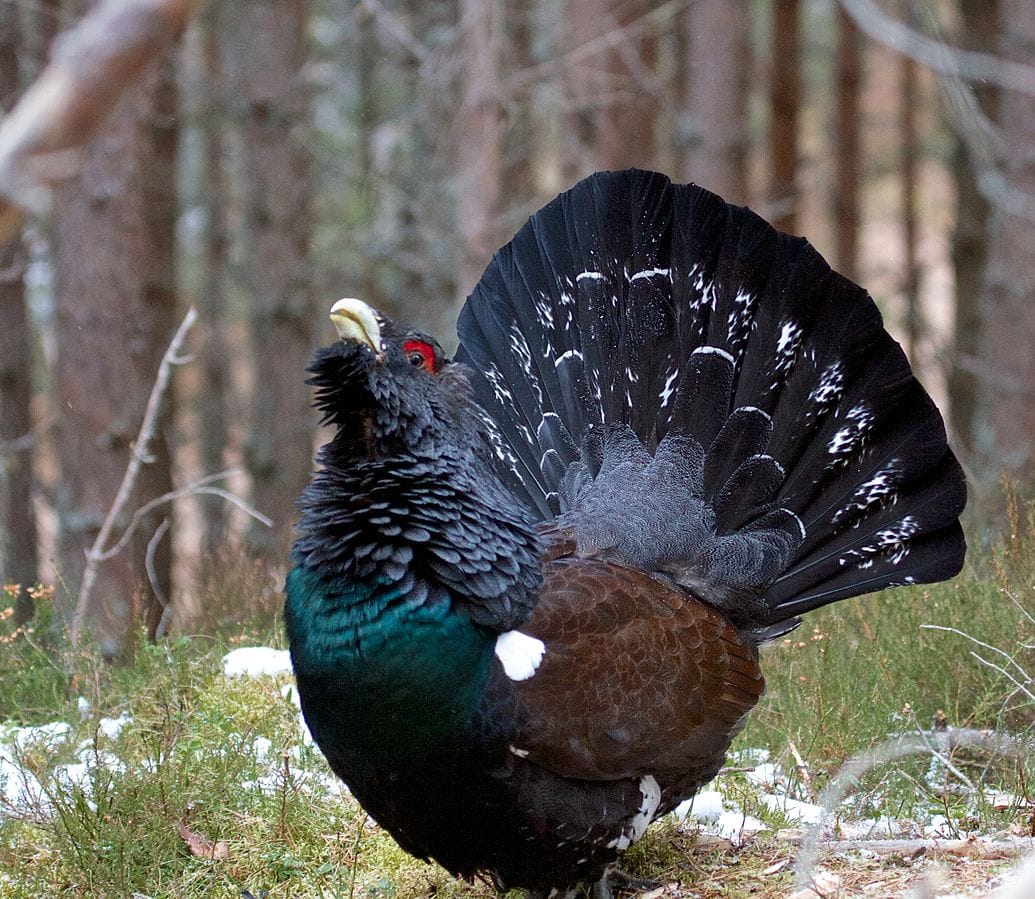
The Western Capercaillie, also known as the wood grouse, is one of the largest grouse species, native to Europe and parts of Asia. Adult males can weigh up to 6 kg, with a wingspan of nearly 4 feet, and exhibit dark plumage with iridescent green and blue highlights. Females are smaller and mottled brown.
These birds are omnivorous, feeding on buds, shoots, berries, and insects. They inhabit old-growth coniferous forests, where males display during spring in cleared areas called leks. Courtship includes puffing up feathers, tail fanning, and deep calls to attract females.
Females lay 6–12 eggs in shallow ground nests, often hidden under shrubs or fallen logs. Predators include foxes, martens, raptors, and humans. Habitat loss and hunting have impacted populations in Europe, prompting conservation programs.
Western Capercaillies are remarkable for their size, elaborate courtship rituals, and forest adaptations. Observing them highlights the diversity and ecological importance of grouses in forest ecosystems.
6. Siberian Capercaillie (Tetrao urogallus sibiricus)
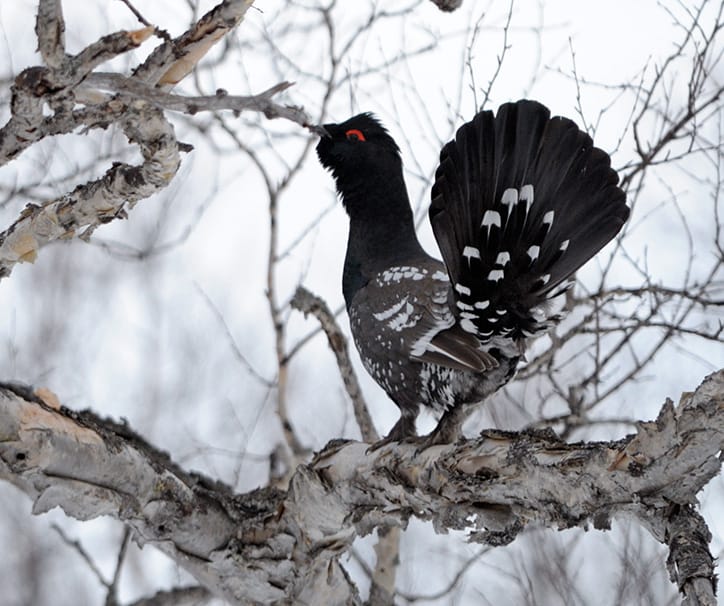
The Siberian Capercaillie is a large grouse species native to the vast taiga forests of Siberia. Males can weigh up to 6 kg and measure nearly 100 cm in length, making them one of the heaviest grouse species. Their plumage is dark with metallic green and blue tones, complemented by a fanned tail and bright red eyebrow combs. Females are significantly smaller and brown with cryptic patterns for camouflage.
Siberian Capercaillies are omnivorous, feeding primarily on pine needles, buds, berries, and insects. They inhabit old-growth coniferous forests, often avoiding human-disturbed areas. Males perform elaborate lekking displays during spring, which include inflating their air sacs, tail fanning, and producing resonant drumming calls to attract females.
Females build nests on the ground, concealed in dense vegetation. They lay 6–12 eggs and provide sole parental care. Predators include foxes, raptors, and martens. Their large size, impressive displays, and forest adaptations make them a flagship species for taiga conservation.
Studying Siberian Capercaillies provides insight into reproductive strategies, habitat specialization, and survival in harsh boreal climates. Their unique courtship behaviors and ecological role emphasize the importance of conserving intact forest ecosystems.
7. Hazel Grouse (Tetrastes bonasia)
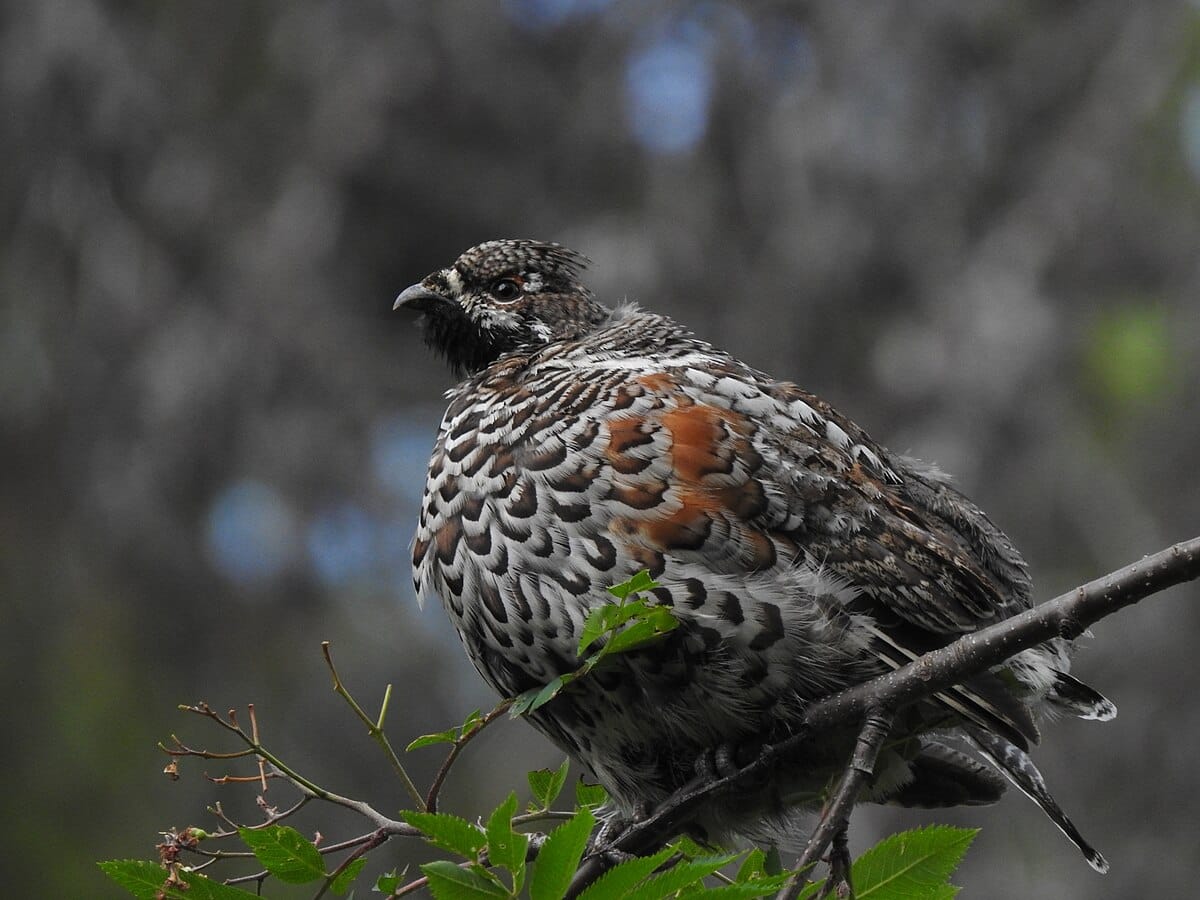
The Hazel Grouse is a small, elusive grouse native to temperate forests of Europe and Asia. Adults measure 35–40 cm in length and have finely barred brown and gray plumage, providing excellent camouflage in dense undergrowth. Males display a black throat patch bordered with white, which is most visible during courtship.
Hazel Grouse are primarily herbivorous, feeding on leaves, buds, berries, and occasionally insects. They prefer dense, moist forests with rich undergrowth and proximity to water sources. Males perform soft whistling calls and short wing-clapping displays to attract females, often in concealed forest areas.
Females build nests on the forest floor, hidden under leaves and vegetation. They lay 4–10 eggs and incubate them alone. Predators include foxes, martens, and birds of prey. Their shy, secretive nature makes them challenging to observe, adding to their allure for birdwatchers.
The Hazel Grouse exemplifies the importance of understory vegetation for ground-dwelling birds. Its behavior, diet, and habitat preferences provide key insights into forest ecosystem dynamics and conservation priorities.
8. Spruce Grouse (Falcipennis canadensis)
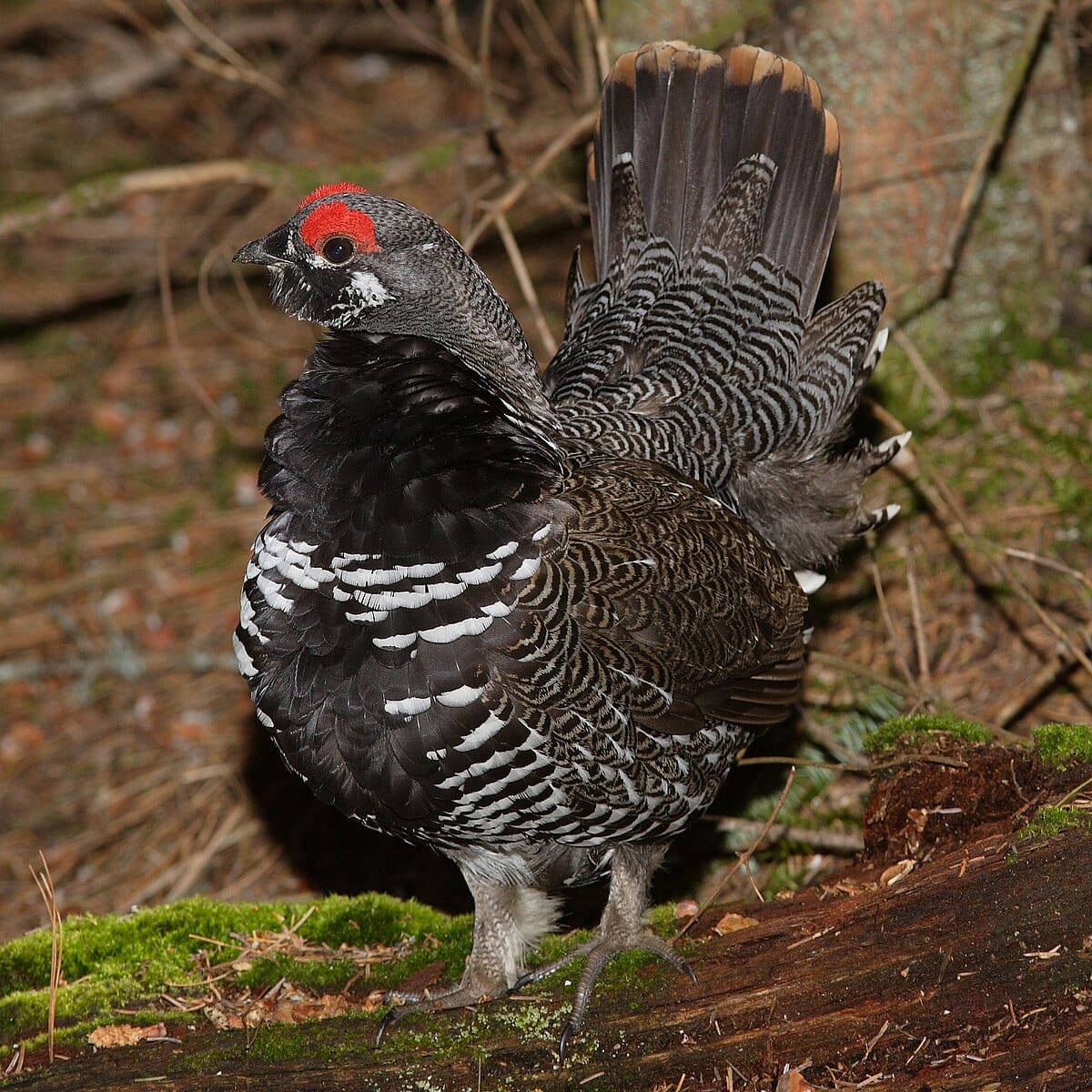
The Spruce Grouse, native to North American boreal forests, is a medium-sized bird measuring 40–45 cm in length. Males are dark gray with fine black and white barring, while females are brownish with mottled patterns for camouflage. A distinctive feature is the male’s red eyebrow comb, used during courtship displays.
Primarily herbivorous, Spruce Grouse feed on spruce needles, berries, and insects, especially during the breeding season. They are well-adapted to cold climates, often remaining in dense spruce forests year-round. Males display by fanning their tails, puffing their chest feathers, and producing soft drumming calls to attract mates.
Females build nests on the ground, often concealed beneath fallen logs or shrubs, and lay 4–8 eggs. Predators include foxes, raptors, and martens. Their reliance on coniferous forests highlights their sensitivity to habitat disturbance and the importance of forest conservation.
Spruce Grouse are fascinating for their unique feeding adaptations and seasonal behaviors. Studying them reveals how specialized forest birds survive in boreal environments and maintain ecological balance.
9. Sooty Grouse (Dendragapus fuliginosus)
The Sooty Grouse, native to western North American coniferous forests, is a large bird measuring 50–65 cm in length. Males are dark gray to black with subtle brown patterns and striking yellow eye combs. Females are mottled brown, providing effective camouflage on the forest floor.
Sooty Grouse are herbivorous, feeding on needles, buds, and berries, with occasional insects. They inhabit montane and subalpine forests, often near meadows or streams. Males engage in lekking displays during spring, performing wing claps, calls, and tail fanning to attract females.
Females nest on the ground among dense vegetation, laying 4–12 eggs. Predators include foxes, martens, and birds of prey. Their large size and reliance on intact coniferous forests make them indicators of forest ecosystem health.
Observing Sooty Grouse provides valuable insights into mating behaviors, seasonal adaptations, and habitat specialization of North American grouse species.
10. Dusky Grouse (Dendragapus obscurus)
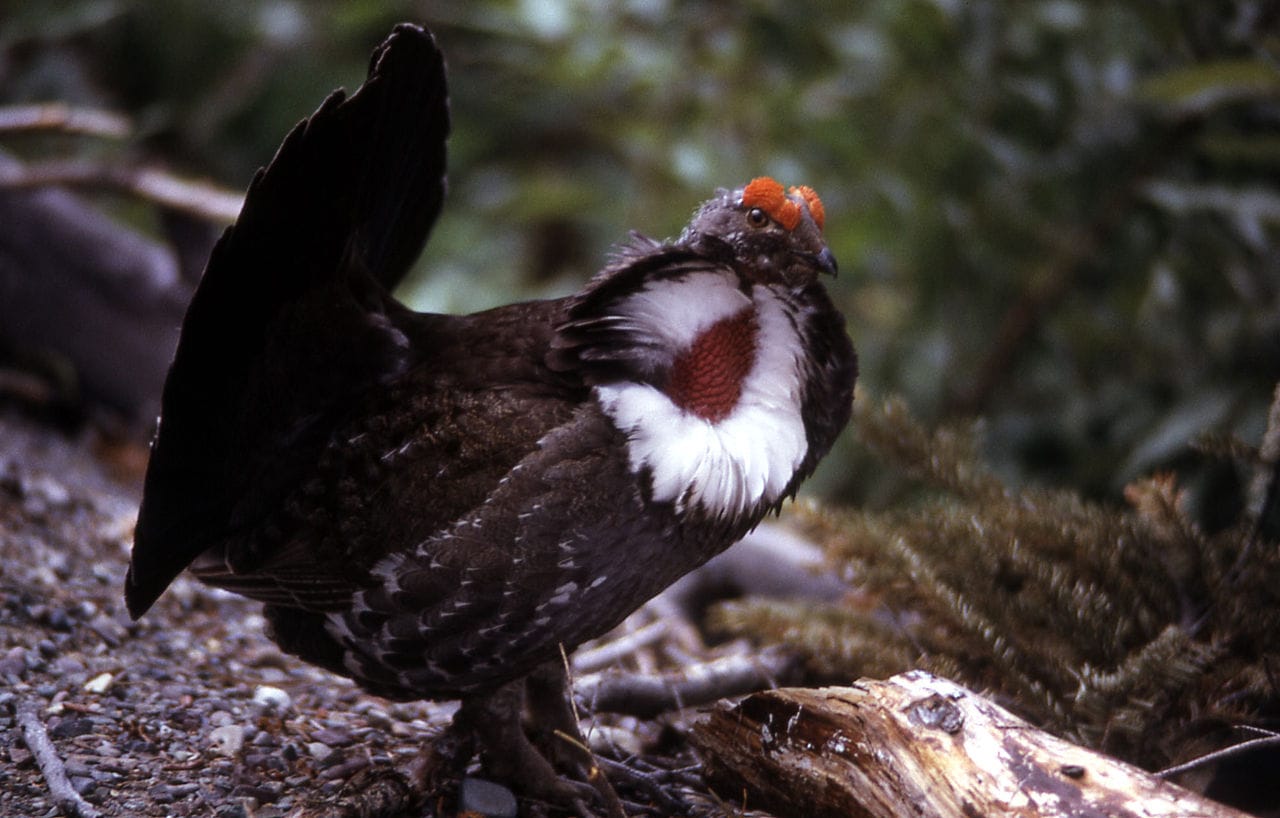
The Dusky Grouse, found in western North America, inhabits montane and subalpine forests. Adults measure 50–65 cm, with males dark gray or brown with a yellow throat wattle, while females are mottled brown for camouflage. Their plumage allows them to blend seamlessly with forest floors and undergrowth.
Herbivorous in diet, Dusky Grouse feed on needles, buds, berries, and insects. They are highly adapted to forested and mountainous habitats. Males display during the breeding season by inflating their esophageal sacs, fanning tails, and performing booming calls to attract females.
Females build nests on the ground under cover and lay 5–10 eggs. Predators include raptors, foxes, and martens. Dusky Grouse play an important ecological role in seed dispersal and insect population control.
Studying Dusky Grouse reveals their adaptation to montane environments, complex mating behaviors, and the critical importance of forest habitats for ground-dwelling birds.
11. Greater Sage-Grouse (Centrocercus urophasianus)
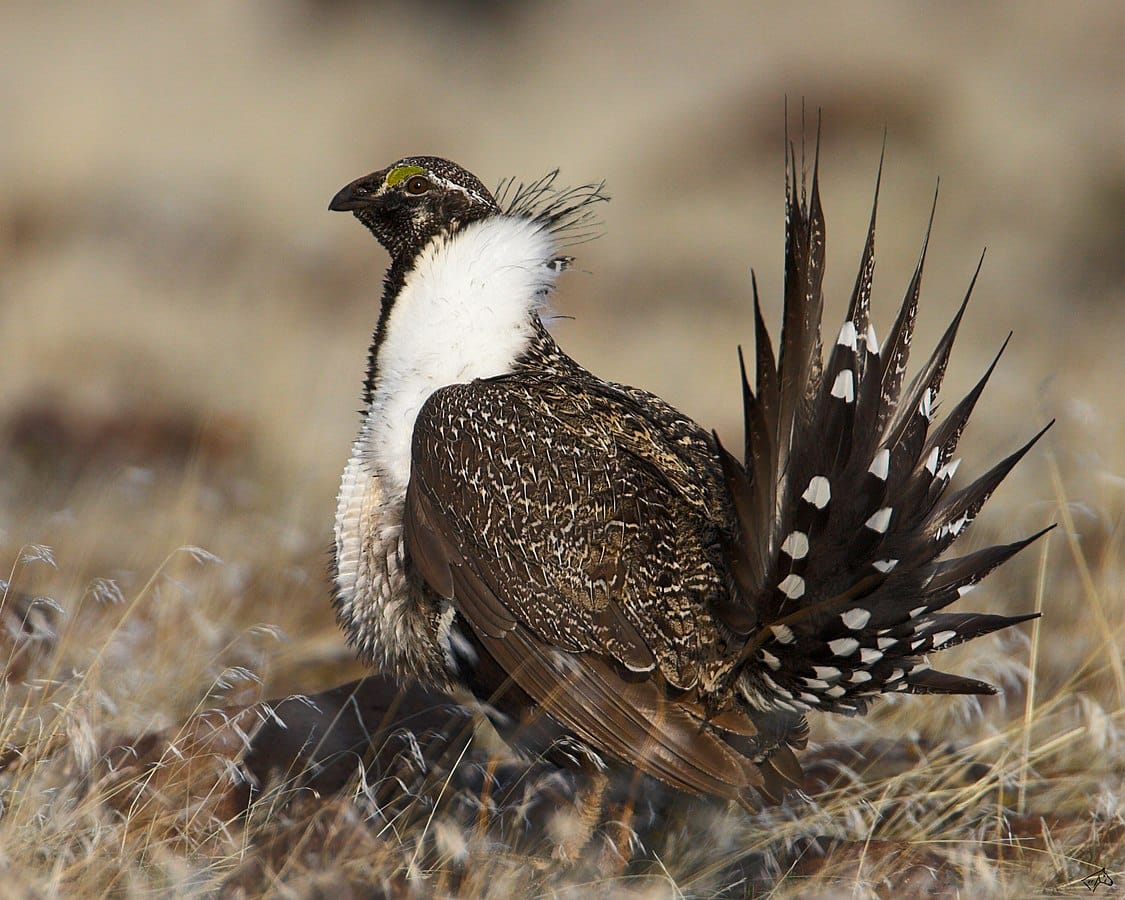
The Greater Sage-Grouse is a striking species native to North America’s sagebrush ecosystems. Males are renowned for their large size, up to 70 cm long, distinctive black chest, long tail feathers, and striking yellow air sacs on their chest used during elaborate mating displays. Females are smaller and cryptically colored in mottled browns for camouflage.
These grouses are herbivorous, feeding primarily on sagebrush leaves, shoots, and buds. During spring, males gather in leks where they perform dramatic strutting displays, inflating their chest sacs, fanning their tails, and producing booming sounds to attract females.
Females build well-hidden ground nests in sagebrush cover, laying 7–12 eggs. Predators include coyotes, foxes, raptors, and humans. Habitat loss from agriculture and energy development has caused population declines, making conservation efforts crucial.
Greater Sage-Grouse exemplify complex social behavior and ecological specialization. Their lekking rituals and dependence on sagebrush habitats make them an iconic species of the American West.
12. Gunnison Sage-Grouse (Centrocercus minimus)
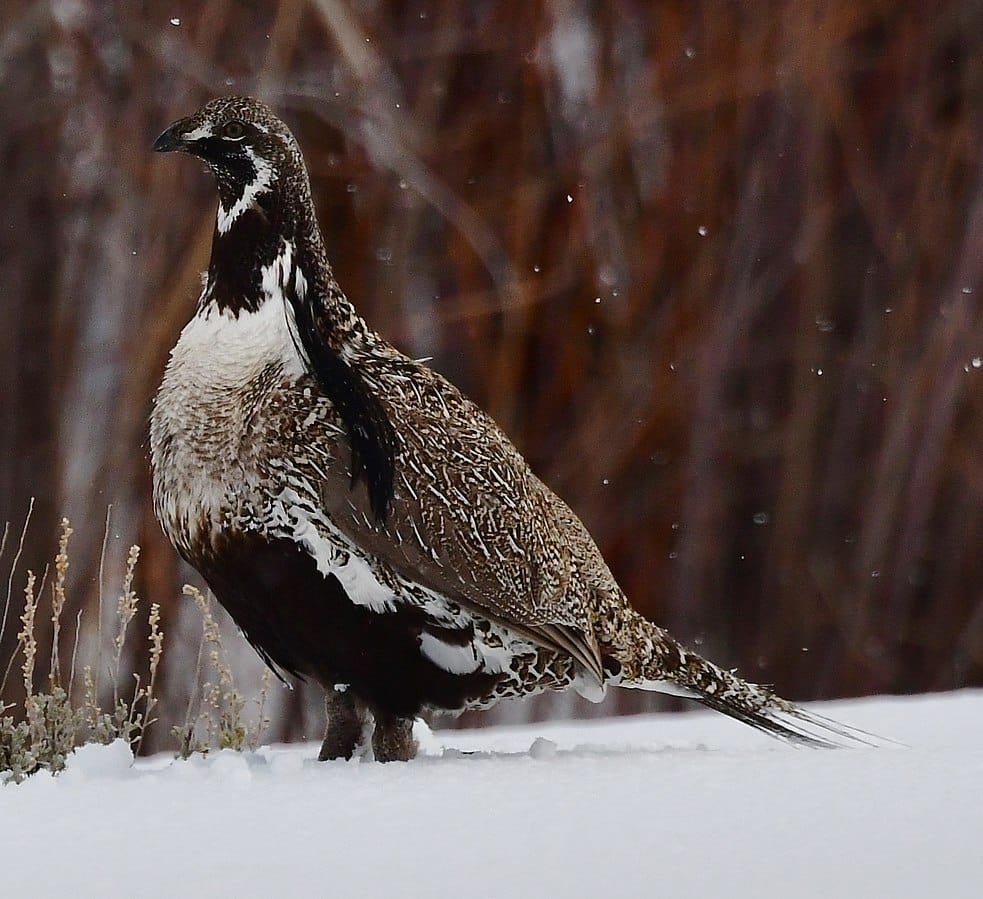
The Gunnison Sage-Grouse is a rare and highly specialized species restricted to southwestern Colorado and southeastern Utah. Males are slightly smaller than Greater Sage-Grouse, with black underparts, white ruffs, and yellow chest sacs used in mating displays. Females are mottled brown for camouflage.
Herbivorous in diet, they feed almost exclusively on sagebrush leaves and shoots. Like their larger relatives, males gather in leks during spring, performing elaborate displays to attract mates. These displays involve puffing their chest sacs, tail fanning, and producing resonant booms.
Females nest on the ground, laying 6–9 eggs in concealed sites among sagebrush. Predators include raptors, foxes, and coyotes. The species faces extreme vulnerability due to limited range and habitat fragmentation, making it a focus of conservation programs.
Studying Gunnison Sage-Grouse provides insight into the challenges of species survival in specialized habitats and the importance of preserving sagebrush ecosystems.
13. Ruffed Grouse (Bonasa umbellus)
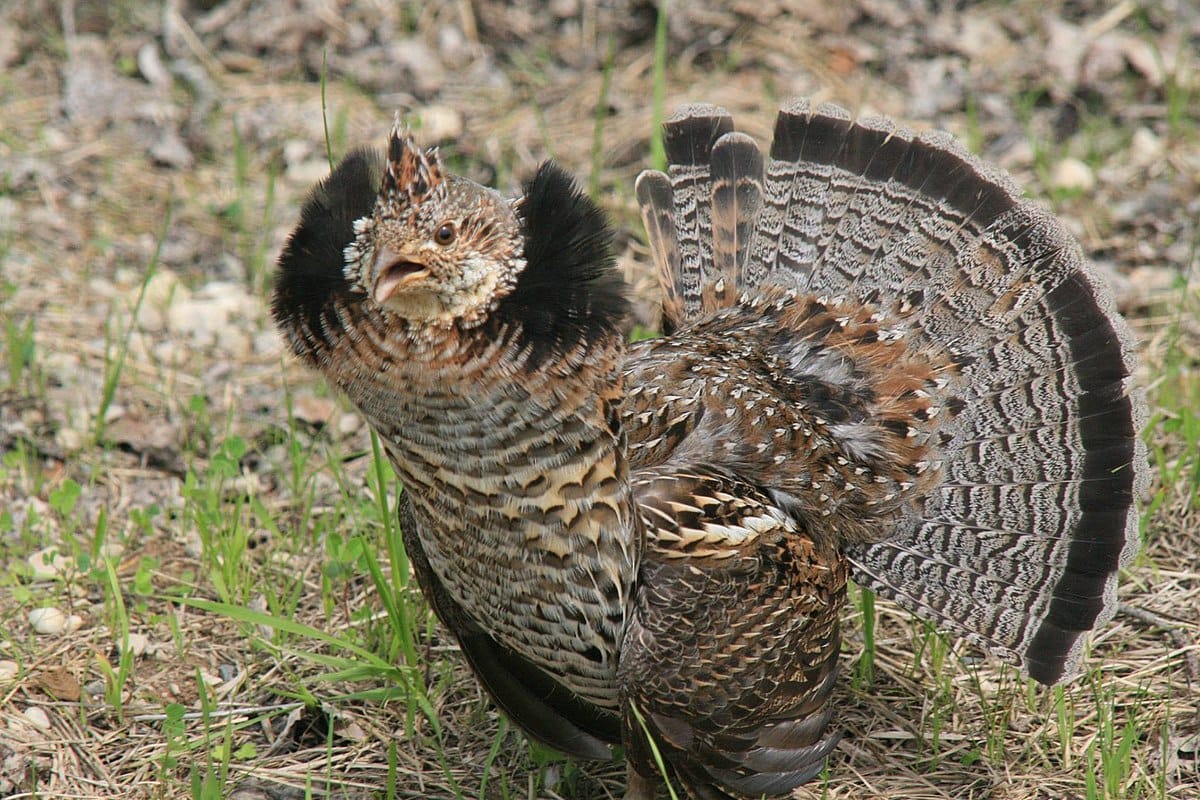
The Ruffed Grouse is a medium-sized grouse native to North American forests. Adults measure 40–50 cm in length, with males and females displaying mottled brown plumage for camouflage. A distinguishing feature is the ruff of feathers around the neck, which males fan during mating displays.
Ruffed Grouse are omnivorous, feeding on buds, leaves, berries, and insects. They prefer mixed hardwood and conifer forests with dense undergrowth. Males perform drumming displays on logs, vibrating air sacs to create low-frequency sounds that attract females.
Females build shallow nests on the forest floor and lay 8–14 eggs. Predators include foxes, hawks, and owls. Ruffed Grouse populations are sensitive to forest management practices, making habitat conservation crucial.
Ruffed Grouse are iconic for their drumming behavior and forest adaptations. Observing their mating displays offers valuable insight into avian communication and territorial behavior.
14. White-breasted Wood-Grouse (Tetrao leucogaster)
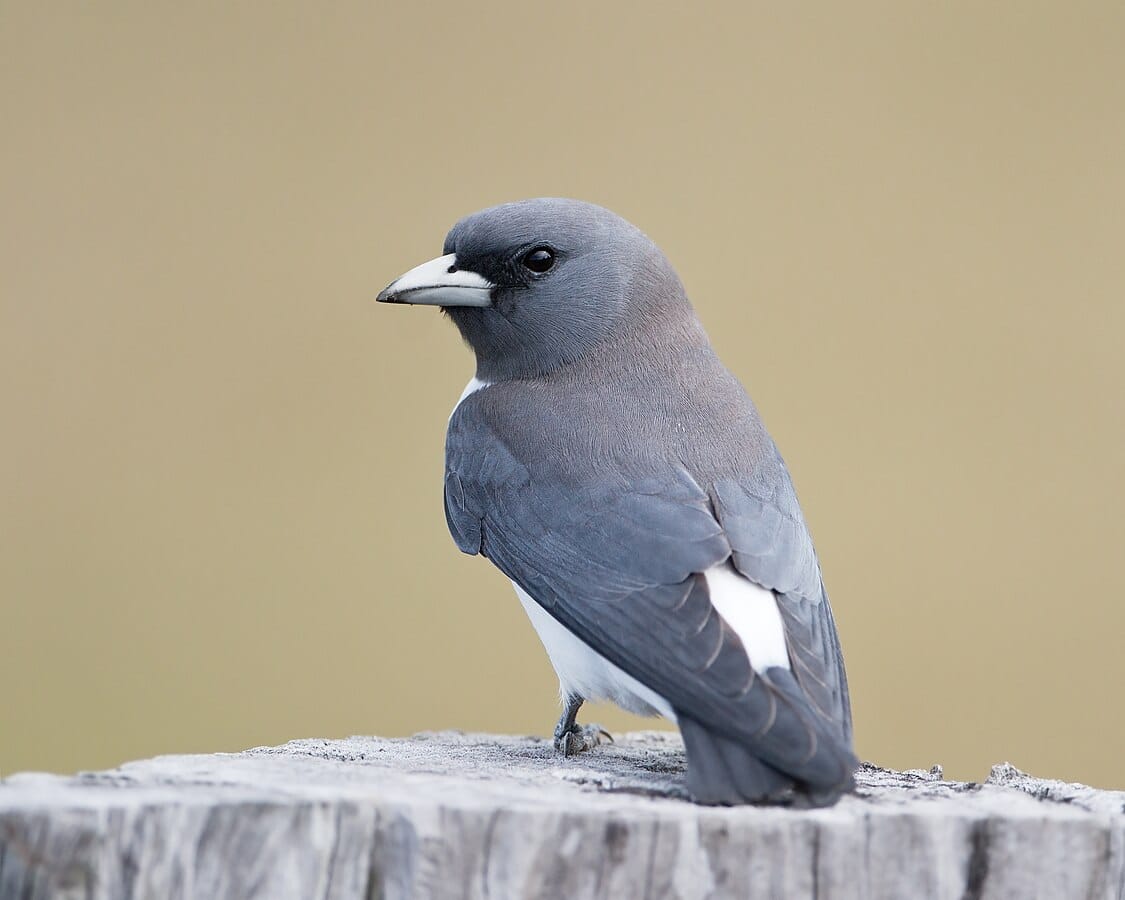
The White-breasted Wood-Grouse is a striking species native to Southeast Asian forests. Adults measure approximately 55–60 cm, with males displaying black bodies, white breasts, and red facial skin. Females are brown and mottled, blending seamlessly with the forest floor.
This grouse is herbivorous, feeding on leaves, shoots, berries, and seeds. They inhabit lowland and montane forests, often near streams or dense vegetation. Males display by puffing up their chest feathers, fanning tails, and performing vocal calls to attract females.
Females lay 3–6 eggs in ground nests concealed by leaves and shrubs. Predators include raptors, snakes, and mammals. Habitat loss due to deforestation poses significant threats, making conservation and habitat protection essential.
White-breasted Wood-Grouse demonstrate the diversity of forest-adapted grouse species. Their distinct plumage and behavioral adaptations make them a captivating subject for wildlife enthusiasts and researchers alike.
15. Black-breasted Wood-Grouse (Tetrao ptilosus)
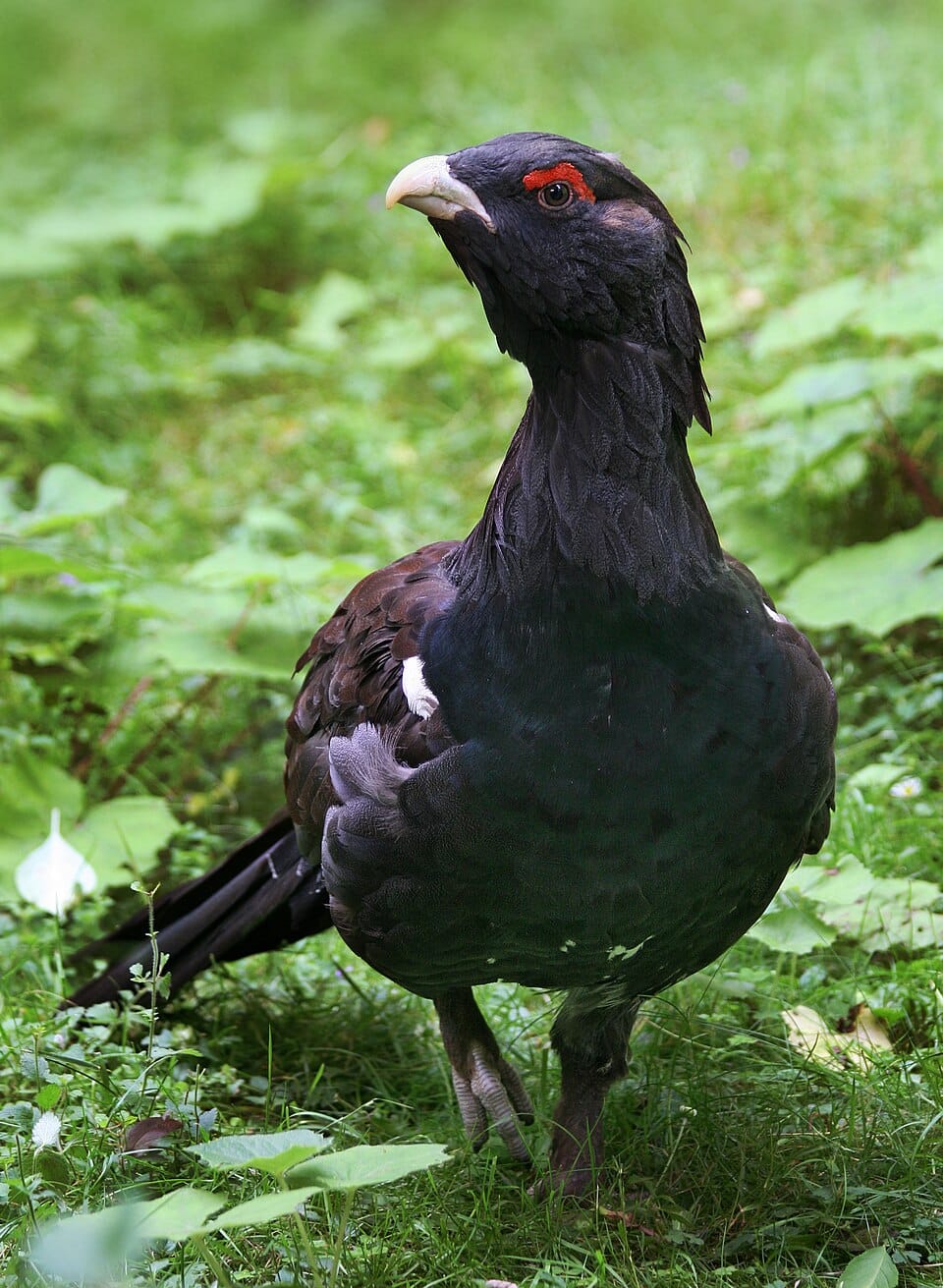
The Black-breasted Wood-Grouse is a rare and elusive species found in the montane forests of Southeast Asia. Males measure 50–55 cm and have glossy black plumage with a distinctive red facial patch. Females are brown and cryptically colored for camouflage.
These grouses are primarily herbivorous, feeding on leaves, buds, berries, and occasionally insects. They inhabit dense montane forests with thick undergrowth, providing cover from predators. Males perform subtle displays by inflating air sacs, fanning tails, and producing low-frequency calls to attract females.
Females build nests on the forest floor and lay 4–7 eggs, relying on camouflage for protection. Predators include raptors, civets, and snakes. Habitat fragmentation and deforestation threaten their populations, highlighting the need for conservation efforts.
Studying Black-breasted Wood-Grouse provides insights into elusive forest species, their survival strategies, and the ecological importance of maintaining dense montane habitats.
16. Red Grouse (Lagopus lagopus scotica)
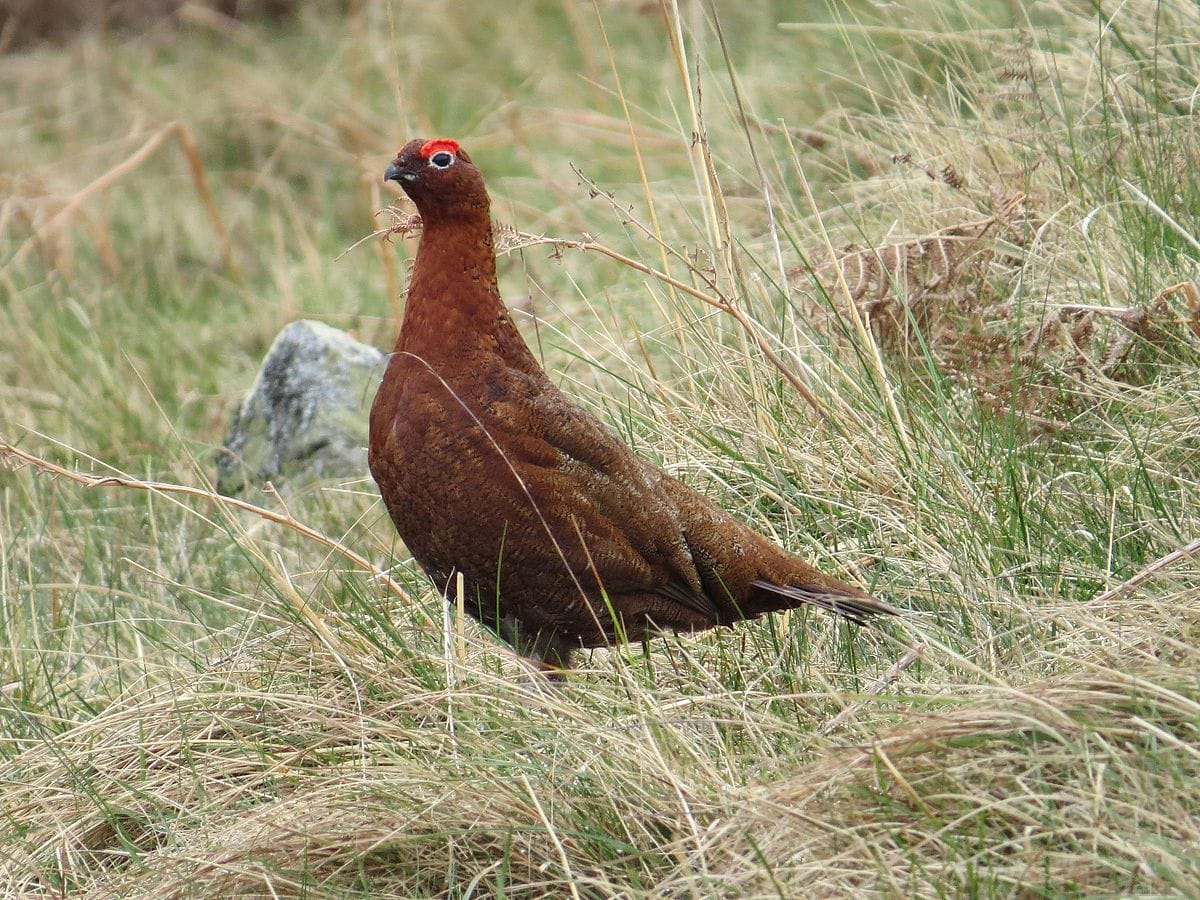
The Red Grouse is a subspecies of the Willow Ptarmigan, endemic to the heather moorlands of the British Isles. Adults are medium-sized, measuring 38–45 cm in length, with males exhibiting rich reddish-brown plumage and subtle barring. Females are slightly paler with mottled patterns, providing effective camouflage against heather and grassy terrain.
Red Grouse are primarily herbivorous, feeding on heather shoots, leaves, and seeds, and occasionally insects. They inhabit open moorlands, often forming small coveys outside the breeding season. Males perform distinct “cackling” calls and short flights to assert territory and attract females during the spring lekking period.
Females build nests on the ground hidden among heather and grasses, laying 6–12 eggs. Predators include foxes, raptors, and stoats. Human activities such as moorland management and hunting can impact populations, making sustainable conservation practices crucial.
Red Grouse are iconic for their adaptation to heathland ecosystems. Their behaviors, diet, and breeding strategies provide valuable insights into the survival of ground-dwelling birds in open landscapes.
17. Blue Grouse (Dendragapus obscurus obscurus)
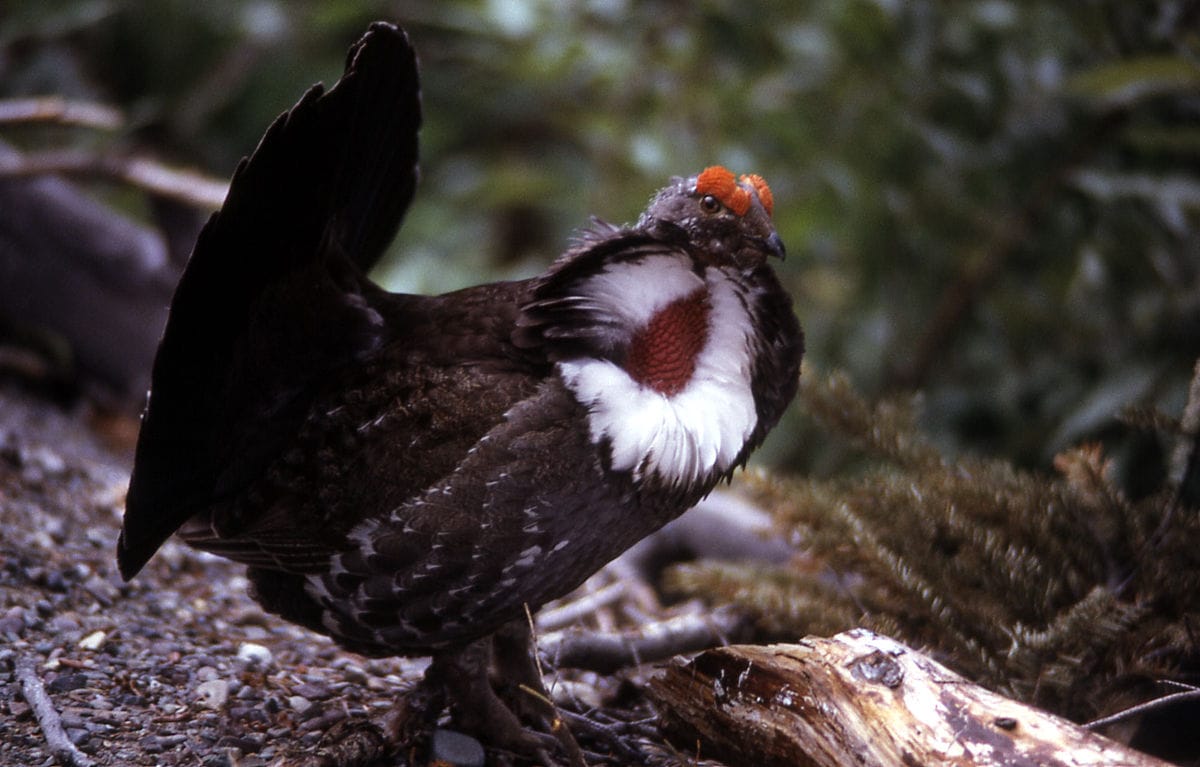
The Blue Grouse is a North American grouse found in coniferous forests and mountainous regions. Adults measure 50–60 cm, with males exhibiting slate-blue plumage and yellow eye combs, while females are mottled brown for camouflage. Their coloration allows them to blend seamlessly with forested habitats.
Blue Grouse are herbivorous, feeding on needles, leaves, buds, berries, and occasionally insects. They prefer dense forests with access to meadows for foraging. Males perform aerial displays, tail fanning, and deep calls during spring to attract females and establish territories.
Females lay 5–10 eggs in shallow ground nests hidden among shrubs and fallen logs. Predators include foxes, raptors, and coyotes. Habitat preservation is essential as logging and development threaten their forest environments.
Observing Blue Grouse reveals unique mating behaviors, seasonal adaptations, and their vital role in forest ecosystems as herbivores and prey for predators.
18. Brown Capercaillie (Tetrao urogallus cantabricus)
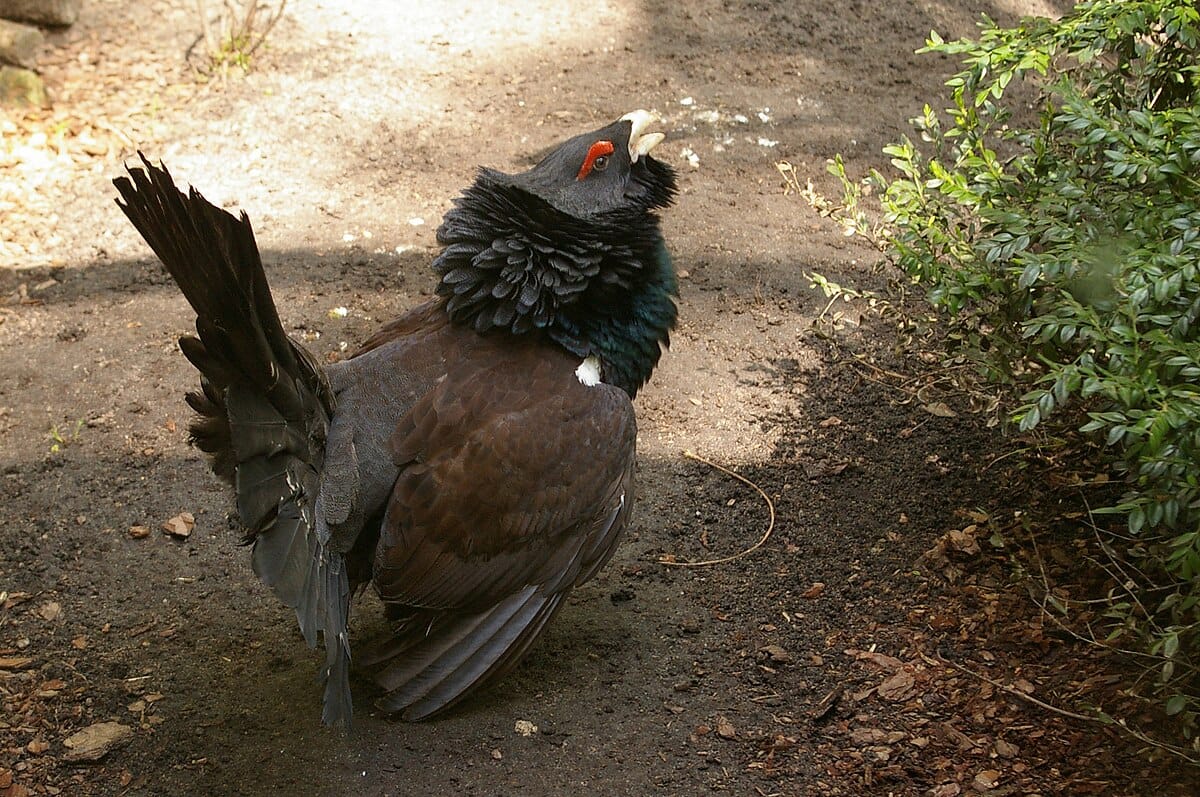
The Brown Capercaillie is a subspecies of the Western Capercaillie, native to the Cantabrian Mountains of Spain. Adults are among the largest grouse species, with males reaching up to 6 kg and a wingspan of nearly 4 feet. Males have dark brown plumage with subtle iridescent highlights, while females are mottled brown for camouflage.
They are omnivorous, feeding on buds, leaves, berries, and insects. These birds inhabit dense old-growth coniferous forests, and males display during spring in leks by fanning their tails, inflating chest air sacs, and performing deep resonant calls to attract females.
Females build nests on the ground, concealed among vegetation, and lay 6–12 eggs. Predators include foxes, martens, and birds of prey. Habitat fragmentation poses a threat to populations, making conservation programs essential.
Brown Capercaillies are remarkable for their size, mating rituals, and dependence on intact forests, serving as a flagship species for European forest conservation.
19. Sharp-tailed Grouse (Tympanuchus phasianellus)
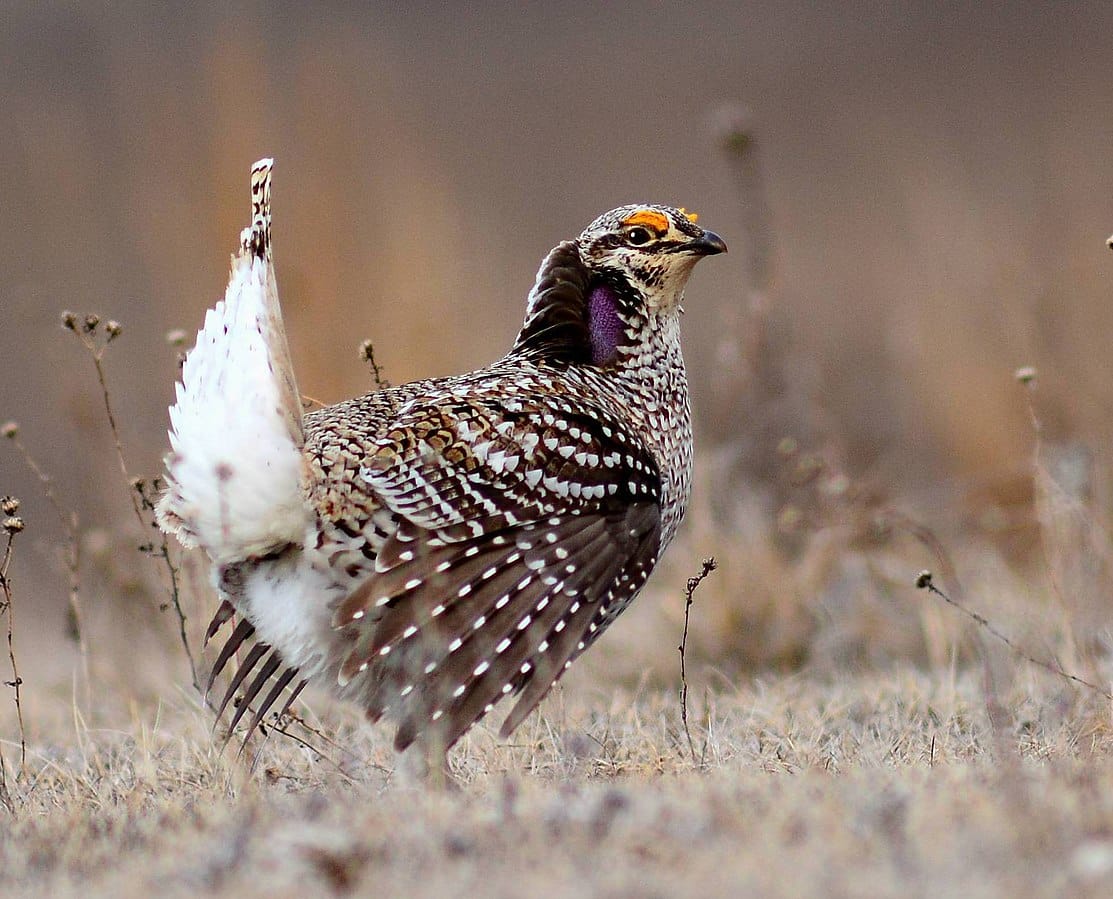
The Sharp-tailed Grouse is a medium-sized bird native to North American prairies and grasslands. Adults measure 40–45 cm, with males exhibiting mottled brown plumage, a distinctive long pointed tail, and colorful air sacs used during mating displays. Females are smaller and cryptically colored.
They are omnivorous, feeding on grasses, seeds, buds, and insects. Males gather in leks during spring to perform elaborate displays, which include strutting, tail fanning, and producing booming calls to attract females.
Females build nests on the ground, often hidden among tall grasses, and lay 7–12 eggs. Predators include raptors, foxes, and coyotes. Conservation efforts focus on maintaining prairie habitats and preventing habitat fragmentation.
Sharp-tailed Grouse are iconic prairie species, providing insights into lekking behaviors, grassland ecology, and the importance of habitat preservation for ground-nesting birds.
20. Greater Prairie-Chicken (Tympanuchus cupido)
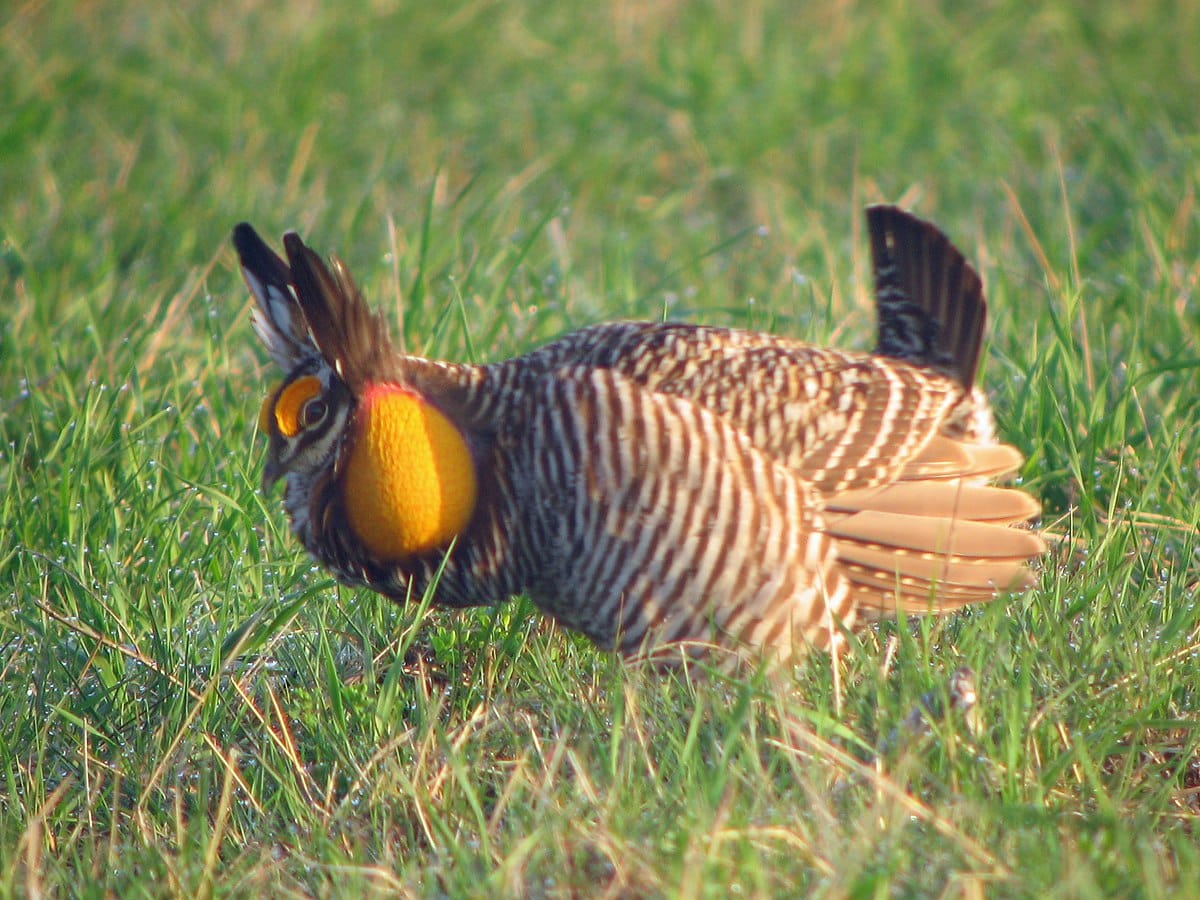
The Greater Prairie-Chicken is a large grouse species native to North American grasslands. Males weigh 1–1.5 kg and exhibit brown mottled plumage, long tail feathers, and bright orange air sacs used in their elaborate mating displays. Females are smaller and more cryptically colored.
These birds are primarily herbivorous, feeding on grasses, seeds, and insects. Males gather in communal leks during spring, performing booming calls, tail fanning, and inflating air sacs to attract mates. The species relies heavily on intact grasslands for survival.
Females nest on the ground in concealed sites and lay 10–14 eggs. Predators include foxes, raptors, and coyotes. Habitat loss due to agriculture and development has caused population declines, making conservation and prairie restoration critical.
Greater Prairie-Chickens are emblematic of North American grassland ecosystems. Their complex mating behaviors and habitat requirements highlight the importance of preserving native prairie landscapes for biodiversity.
21. Lesser Prairie-Chicken (Tympanuchus pallidicinctus)
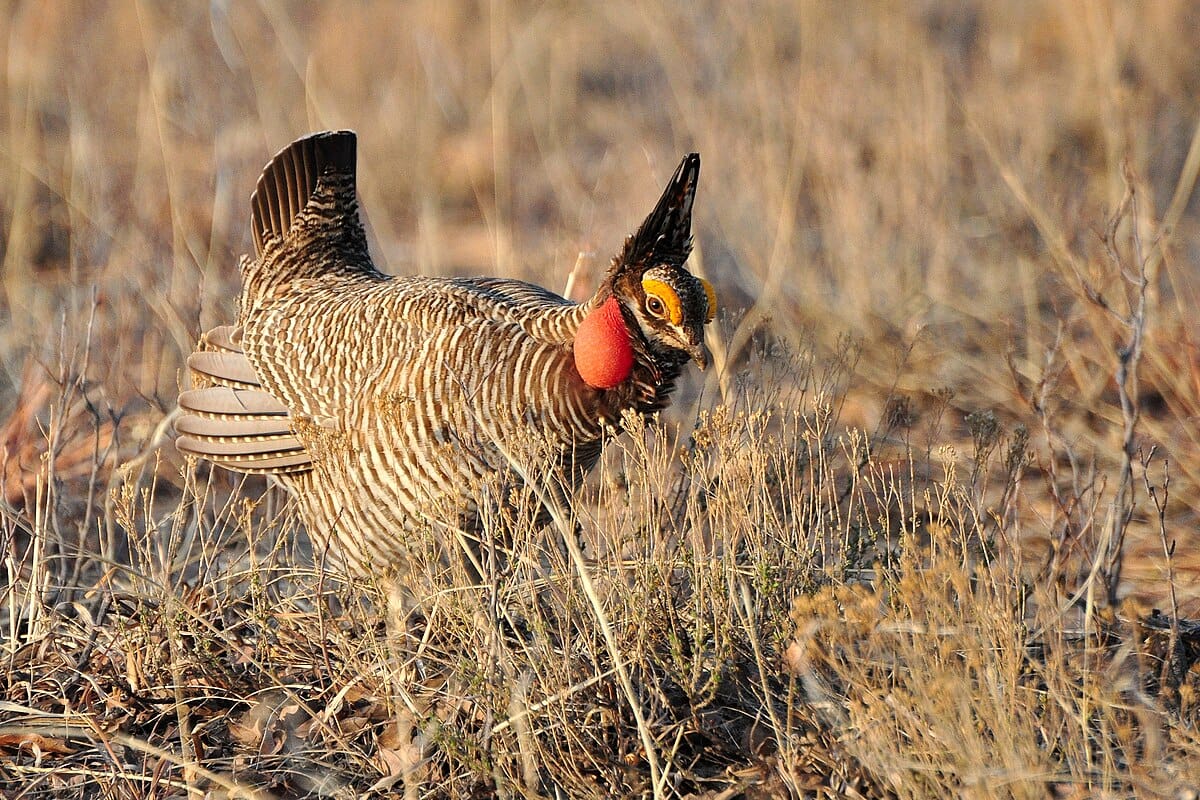
The Lesser Prairie-Chicken is a small North American grouse species native to the southern Great Plains. Males are slightly smaller than the Greater Prairie-Chicken, measuring 40–45 cm in length, and display reddish-brown plumage with distinctive black barring and bright orange air sacs used during courtship displays. Females are mottled brown, blending perfectly with grasses and shrubs.
Lesser Prairie-Chickens are herbivorous, feeding on seeds, grasses, and insects. Males gather in leks during spring to perform elaborate displays, including booming calls, tail fanning, and inflating their air sacs to attract females. The species is highly dependent on intact grassland and shrubland habitats.
Females build nests on the ground among dense vegetation and lay 8–12 eggs. Predators include coyotes, foxes, and raptors. Habitat loss, fragmentation, and energy development have caused population declines, making conservation programs critical.
Studying Lesser Prairie-Chickens provides insight into lekking behavior, grassland ecology, and the challenges of species survival in fragmented habitats.
22. Buff-throated Grouse (Dendragapus albus)
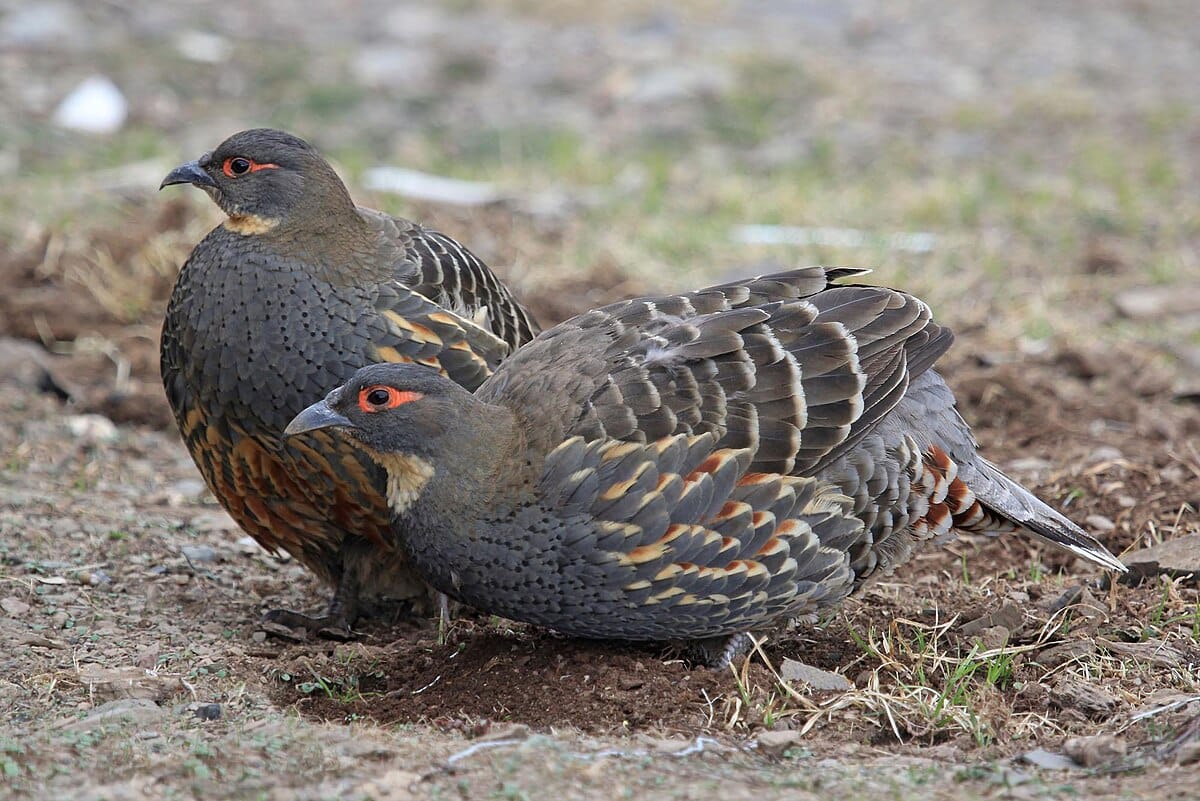
The Buff-throated Grouse is a medium-sized bird found in high-altitude forests of North America. Adults measure 50–55 cm, with males exhibiting dark gray plumage, a buff-colored throat, and yellow eye combs. Females are mottled brown with subtle barring for camouflage.
Buff-throated Grouse are primarily herbivorous, feeding on buds, leaves, berries, and occasionally insects. They inhabit coniferous and mixed forests, often near meadows for foraging. Males perform courtship displays during spring, including tail fanning, wing clapping, and vocal calls to attract females.
Females nest on the ground under shrubs or fallen logs, laying 4–8 eggs. Predators include foxes, raptors, and martens. Maintaining intact forest habitats is critical for their survival.
Buff-throated Grouse are fascinating for their mating rituals, seasonal behaviors, and adaptations to forested environments, providing valuable insights into montane grouse ecology.
23. Chestnut-bellied Partridge-Grouse (Tetrao castaneiventris)
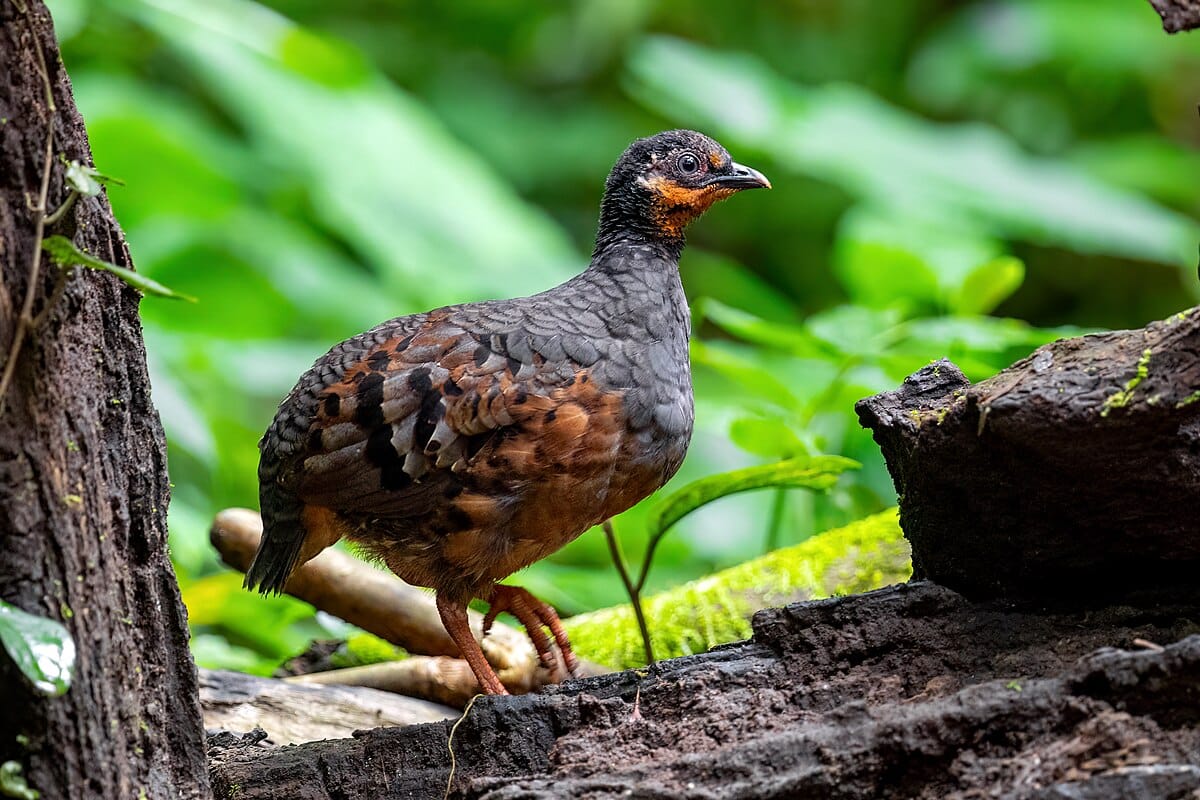
The Chestnut-bellied Partridge-Grouse is a forest-dwelling species native to Southeast Asia. Adults measure 45–50 cm, with males exhibiting glossy dark plumage and a rich chestnut-colored belly. Females are mottled brown for camouflage among leaf litter.
This species is primarily herbivorous, feeding on leaves, berries, and seeds, occasionally supplemented with insects. They inhabit subtropical and tropical forests with dense undergrowth. Males display by fanning their tails, puffing chest feathers, and performing soft calls to attract females.
Females nest on the forest floor, laying 4–7 eggs in concealed locations. Predators include raptors, civets, and snakes. Habitat loss due to deforestation threatens their populations.
Chestnut-bellied Partridge-Grouse are remarkable for their camouflage, forest adaptations, and subtle mating behaviors, making them a captivating subject for wildlife enthusiasts and conservationists.
24. Chinese Grouse (Tetrastes sewerzowi)
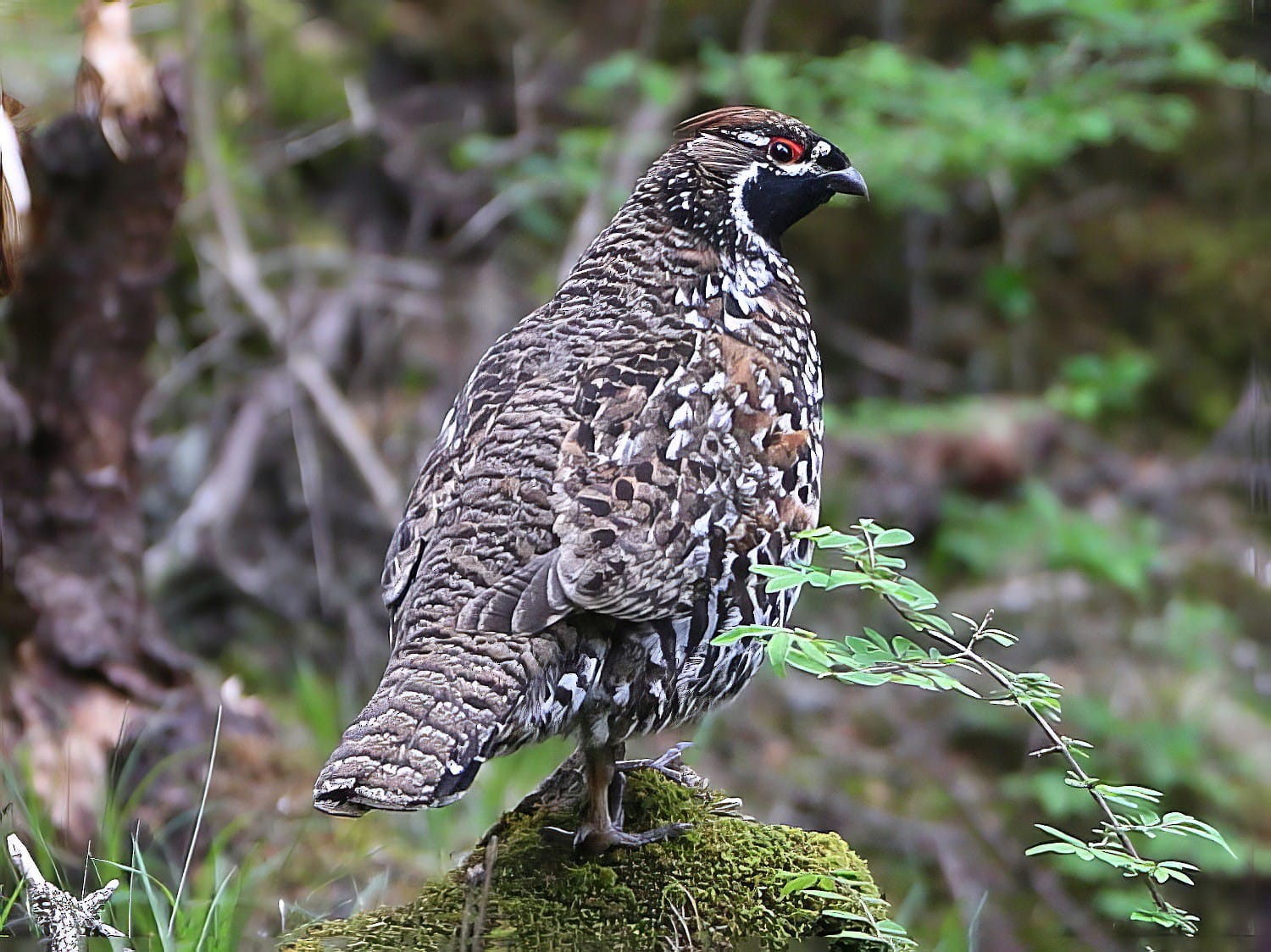
The Chinese Grouse is a rare forest grouse species endemic to central China. Adults measure 40–45 cm, with males displaying dark gray plumage and subtle markings, while females are brown and cryptically patterned. Their plumage provides excellent camouflage in coniferous and mixed forests.
Chinese Grouse are herbivorous, feeding on needles, leaves, buds, berries, and occasional insects. Males perform low-key courtship displays in spring, including tail fanning, soft calls, and gentle strutting to attract mates. They prefer dense forests with minimal disturbance.
Females nest on the ground, hidden among leaf litter, and lay 5–7 eggs. Predators include raptors, foxes, and snakes. Habitat conservation is critical due to deforestation and human encroachment.
Studying Chinese Grouse highlights forest specialization, survival strategies, and the importance of protecting dense forest ecosystems for endemic species.
25. Hill Partridge-Grouse (Tetrao montanus)
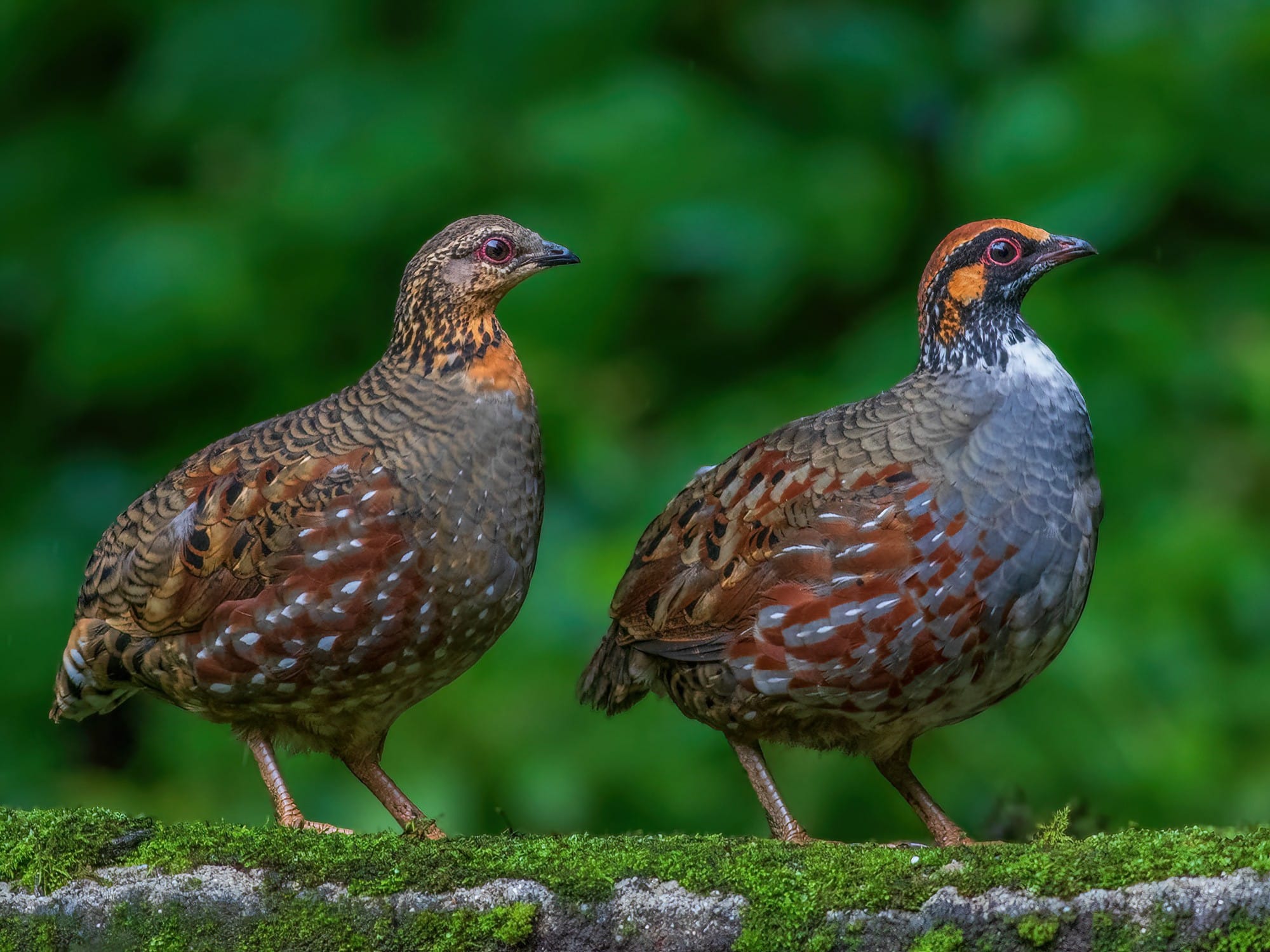
The Hill Partridge-Grouse is a medium-sized grouse native to hilly and montane forests of Asia. Adults measure 40–45 cm, with males exhibiting dark plumage with subtle barring and a small red facial patch, while females are brown and mottled for camouflage.
They are primarily herbivorous, feeding on leaves, buds, berries, and insects. Their habitat preference includes dense forests and forest edges with thick undergrowth. Males perform gentle courtship displays by fanning tails, puffing chest feathers, and calling softly during spring.
Females build nests on the ground and lay 4–8 eggs, concealed among foliage. Predators include raptors, civets, and small mammals. Habitat loss due to deforestation is a primary threat.
Hill Partridge-Grouse provide insight into montane forest adaptations, camouflage strategies, and subtle mating behaviors among ground-dwelling birds.
26. Blyth’s Tragopan (Tragopan blythii)
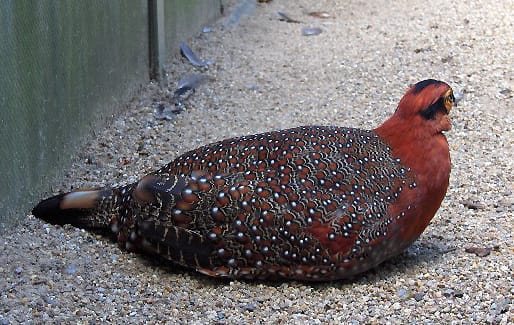
Blyth’s Tragopan is a striking forest grouse native to the eastern Himalayas. Adults measure 55–60 cm, with males displaying bright red plumage adorned with white spots, blue facial skin, and orange horns during the breeding season. Females are cryptically colored in mottled brown and gray to blend with leaf litter.
These birds are primarily herbivorous, feeding on leaves, buds, fruits, and occasionally insects. Males perform spectacular courtship displays by inflating throat sacs, spreading neck feathers, and showcasing vibrant horns to attract females. They inhabit dense montane forests with thick understory vegetation.
Females nest on the ground in concealed areas and lay 3–6 eggs. Predators include raptors, snakes, and small carnivores. Habitat loss due to deforestation and human encroachment poses a serious threat to their populations.
Blyth’s Tragopan exemplifies vibrant coloration, unique mating behaviors, and forest adaptations, making it one of the most captivating grouse species in Asia.
27. Temminck’s Tragopan (Tragopan temminckii)
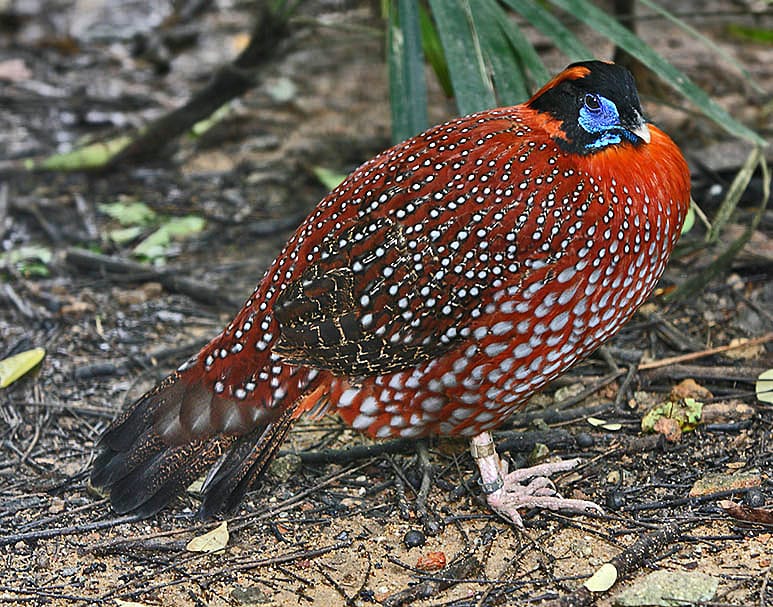
Temminck’s Tragopan is a medium-sized pheasant-like grouse native to Himalayan forests. Adults measure 55–60 cm, with males exhibiting bright red plumage, intricate white spots, and colorful facial skin. Females are mottled brown with subtle markings for camouflage.
Herbivorous in diet, they feed on leaves, berries, fruits, and insects. Males perform elaborate courtship displays in spring, inflating throat sacs, fanning tail feathers, and producing soft vocal calls to attract mates. They prefer dense montane forests with thick understory.
Females nest on the ground, laying 3–6 eggs in concealed locations. Predators include raptors, snakes, and small mammals. Habitat destruction due to logging and agriculture threatens their survival.
Temminck’s Tragopan showcases the importance of colorful courtship behaviors, forest specialization, and habitat conservation for montane grouse species.
28. Satyr Tragopan (Tragopan satyra)
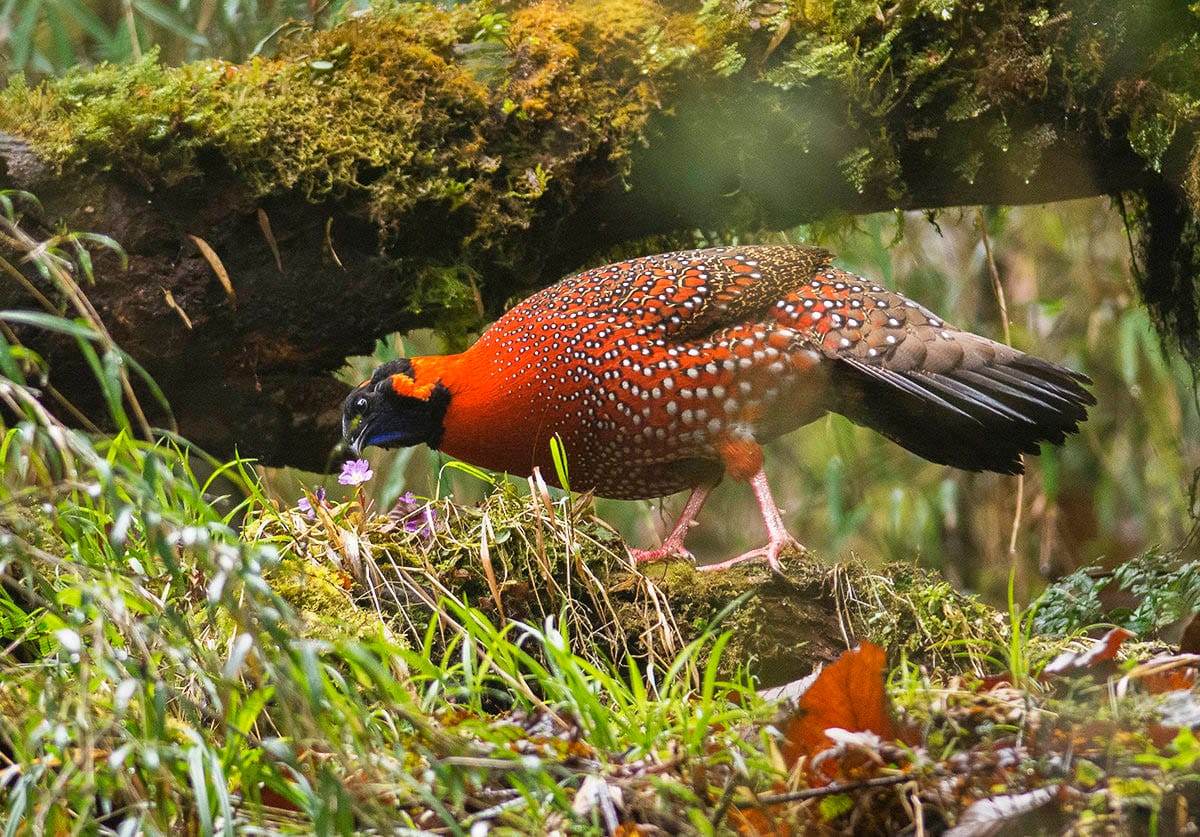
The Satyr Tragopan is a vibrant grouse species native to Himalayan forests and foothills. Adults measure 55–60 cm, with males exhibiting red plumage with white spots, blue facial skin, and fleshy horns used during mating displays. Females are cryptically colored in brown and gray tones.
Satyr Tragopans are herbivorous, feeding on leaves, fruits, berries, and insects. Males perform dramatic courtship displays by inflating throat sacs, showcasing horns, and fanning tails to attract females. They inhabit dense montane forests, often in areas with bamboo understory.
Females build nests on the ground, laying 3–5 eggs in hidden locations. Predators include raptors, snakes, and civets. Habitat loss due to logging and human disturbance poses significant challenges.
Studying Satyr Tragopans highlights unique evolutionary adaptations for mating, forest specialization, and the survival of vibrant grouse species in complex ecosystems.
29. Cabot’s Tragopan (Tragopan caboti)
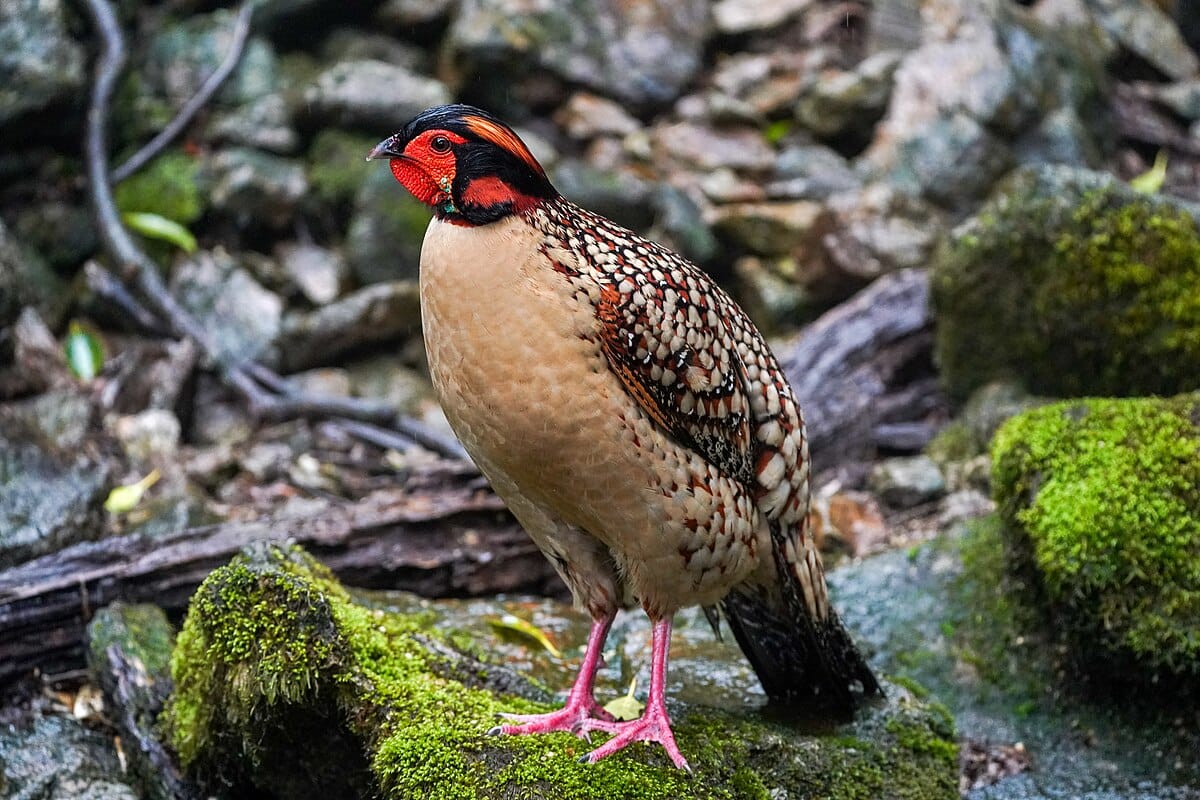
Cabot’s Tragopan is a rare forest grouse endemic to southeastern China. Adults measure 55–60 cm, with males displaying bright red plumage, blue facial skin, and ornate horns during courtship. Females are mottled brown with cryptic patterns.
This species is herbivorous, feeding on leaves, fruits, berries, and insects. Males perform spectacular displays by inflating throat sacs, fanning tails, and showcasing horns to attract mates. They inhabit dense subtropical forests with minimal human disturbance.
Females nest on the ground, laying 3–5 eggs in concealed locations. Predators include raptors, snakes, and small mammals. Conservation concerns focus on habitat destruction and fragmentation.
Cabot’s Tragopan exemplifies the importance of dense forest habitats, vibrant courtship behavior, and species-specific adaptations among montane grouse.
30. Western Capercaillie – Pyrenean Subspecies (Tetrao urogallus aquitanicus)
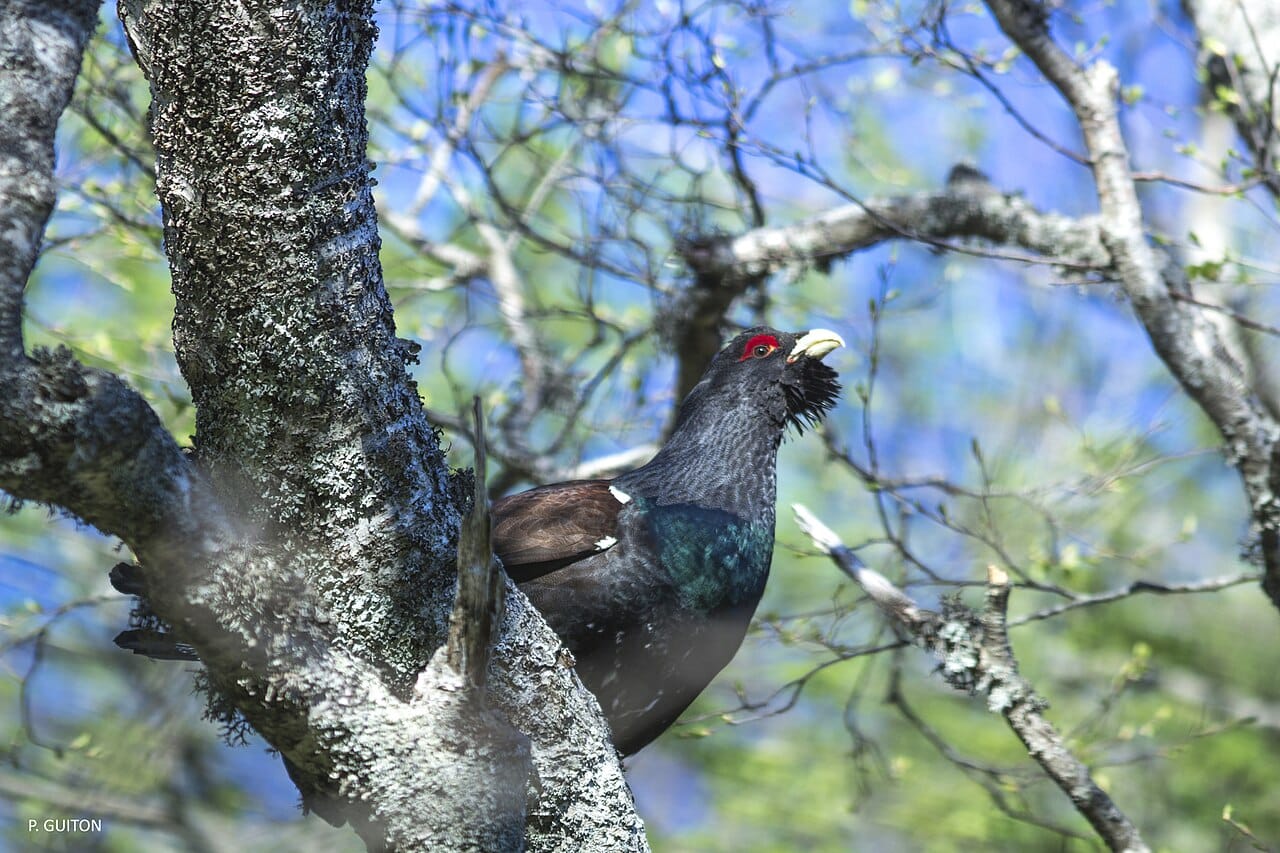
The Pyrenean Capercaillie is a subspecies of the Western Capercaillie native to the Pyrenees mountains of France and Spain. Adult males are large, weighing up to 5.5 kg with a wingspan of nearly 4 feet, and display dark plumage with green and blue iridescence. Females are smaller and cryptically brown.
They are omnivorous, feeding on buds, leaves, berries, and insects. Males perform spring lekking displays, which include tail fanning, inflating chest air sacs, and deep resonant calls to attract females. They inhabit old-growth coniferous forests with minimal disturbance.
Females lay 6–12 eggs in ground nests concealed among vegetation. Predators include foxes, martens, and raptors. Conservation efforts focus on habitat preservation due to hunting and forest fragmentation.
The Pyrenean Capercaillie is remarkable for its size, lekking behavior, and dependence on pristine forest habitats, highlighting the importance of conservation in mountainous ecosystems.
FAQ’s
1. What is another name for a grouse bird?
Another name for a grouse bird is a “game bird.” They belong to the pheasant family, and in some regions, they’re also called “moor birds” or “heath birds” because they often live in moorlands and heaths. In Scotland, “red grouse” is the most common local term.
2. What is the most common grouse?
The most common grouse species in the world is the Ruffed Grouse. Found throughout North America, this bird is famous for its drumming sound made by flapping its wings rapidly. In the UK, the Red Grouse holds that title as the most widespread native species.
3. Is a partridge a type of grouse?
No, a partridge isn’t a type of grouse, though they look somewhat similar. Partridges belong to a different group in the pheasant family and prefer farmland or grassland, while grouse are more often found in cold, forested, or moorland areas.
4. Is grouse a type of bird?
Yes, grouse are indeed birds! They belong to the order Galliformes, the same group that includes chickens, turkeys, and pheasants. Grouse are ground-dwelling birds known for their rounded bodies, short wings, and strong legs that help them move easily through dense brush and snow.
5. What is a nickname for a grouse?
In some places, grouse are affectionately called “drummers” because of the unique drumming noise the males make during mating season. In the UK, hunters often refer to them simply as “birds,” especially when talking about red grouse during shooting season.
6. What is the famous grouse bird?
The famous grouse bird is the Red Grouse, a symbol of Scotland and the namesake of the well-known whisky brand “The Famous Grouse.” It’s a distinctive bird with reddish-brown feathers and bright red eyebrows, found mainly in the Scottish Highlands.
7. What is the name of the famous grouse?
The name “The Famous Grouse” actually comes from Scotland’s most iconic game bird, the Red Grouse. It’s also the name of a popular Scotch whisky that uses the bird as its emblem, representing Scottish pride and tradition.
8. What is the prettiest grouse?
Many bird lovers consider the Spruce Grouse or the Greater Sage-Grouse to be the prettiest. The males display stunning feather patterns and perform elaborate courtship dances, showing off their colorful plumage to attract females during mating season.
9. How many types of grouse are there in the UK?
There are four types of grouse in the UK: the Red Grouse, Black Grouse, Capercaillie, and Ptarmigan. Each species lives in different habitats — from open moorlands to mountain slopes — and all are treasured parts of Britain’s wildlife heritage.
10. Is a pheasant the same as a grouse?
Not exactly. Pheasants and grouse belong to the same bird family but are different species. Pheasants are larger, longer-tailed, and more colorful, while grouse are stockier with shorter tails and are better adapted to cold environments.
11. What the heck is a partridge?
A partridge is a small, round game bird related to pheasants. They’re best known from the Christmas song “The Twelve Days of Christmas,” but in reality, they’re farmland birds that feed on seeds and insects. Common species include the Grey Partridge and the Red-Legged Partridge.
12. What is grouse in Australia?
There aren’t any native grouse species in Australia. However, people there sometimes use the term “grouse” as slang meaning “great” or “awesome.” So, while you won’t find the bird, you might hear someone say, “That’s grouse!” meaning something really good.
13. What is a small grouse called?
A small grouse is often called a “chick” when young or simply a “lesser” species, like the Lesser Prairie-Chicken, which is actually a type of grouse. The Willow Ptarmigan is also one of the smaller members of the grouse family.
14. What is a grouse in British slang?
In British slang, “grouse” can mean to complain or grumble about something. For example, someone might say, “Stop grousing about the weather!” But when talking about wildlife, it usually refers to the bird itself, especially in hunting circles.
15. Which is the largest grouse?
The Capercaillie, found in parts of Europe and Scotland, is the largest member of the grouse family. Males can weigh up to 14 pounds (6.5 kg) and are famous for their dramatic courtship displays, deep calls, and powerful flight through the forest.
16. What is the smallest grouse?
The smallest grouse is the Willow Ptarmigan, also known as the Willow Grouse. It’s a compact bird found in Arctic and subarctic regions. During winter, its feathers turn completely white for camouflage in the snow — an amazing natural adaptation!
17. What animal is the famous grouse?
The “famous grouse” refers to the Red Grouse, a bird native to the British Isles. It’s featured on the label of the world-famous Scotch whisky brand “The Famous Grouse,” which celebrates this iconic Scottish bird and its wild beauty.
18. What is a lek?
A lek is a gathering of male birds, including some grouse species, that compete for the attention of females through displays, sounds, and dances. Each male shows off in his small territory, trying to impress potential mates — like a natural bird dance-off!
19. Is grouse good to eat?
Yes, grouse is considered a delicacy in many countries. Its meat is dark, lean, and flavorful with a gamey taste. In the UK, it’s especially popular during the “Glorious Twelfth” — the start of the hunting season on August 12th.
20. Is a partridge the same as a grouse?
No, a partridge and a grouse are different species, even though they’re both game birds. Partridges are smaller, live in farmland, and rarely perch in trees. Grouse prefer colder, wilder habitats like moorlands and boreal forests.
21. What are the white grouse in the UK?
The white grouse seen in the UK are Ptarmigans. They live in the Scottish Highlands and change color with the seasons — brown in summer and pure white in winter. This helps them blend perfectly into their surroundings all year round.
22. Are grouse birds friendly?
Wild grouse are usually shy, but some individuals, especially males, can become surprisingly tame or curious around humans. During the breeding season, they may even approach people or display proudly nearby!
23. Are turkeys a type of grouse?
Turkeys and grouse belong to the same large bird order, Galliformes, but they’re different species. Turkeys are much larger and more social, while grouse are smaller, solitary, and adapted to colder or mountainous regions.
24. What does a Scottish grouse look like?
The Scottish Red Grouse has rich reddish-brown feathers, a short tail, and bright red eyebrows. Males are slightly darker and more robust than females. Their plumage blends perfectly with heather, making them masters of camouflage on the moors.
25. What do you call a baby grouse?
A baby grouse is called a “chick.” Like most ground-nesting birds, grouse chicks are precocial, meaning they can walk and feed themselves soon after hatching, though they still stay close to their mother for protection.
26. What is a pack of grouse called?
A group of grouse is called a “covey” or sometimes a “drumming” of grouse. These terms are often used by birdwatchers and hunters when describing small flocks feeding or flying together.
27. What is the lifespan of a grouse?
Most grouse live around 3 to 5 years in the wild, though some individuals can survive longer in safe environments. Predators, weather, and hunting all play a big role in how long they live.
28. How fast can a grouse fly?
Grouse are strong, explosive fliers. They can reach speeds of up to 50 miles per hour (80 km/h) in short bursts. However, they don’t fly long distances — they prefer quick, powerful flights to escape predators.
29. Can grouse be aggressive?
Yes, especially during the breeding season. Male grouse can be quite territorial and may even confront humans who get too close to their area. Outside the mating period, though, they tend to be calm and elusive birds.
30. Why is there no grouse this year?
A drop in grouse numbers can happen due to poor weather, habitat loss, or disease. Harsh winters and wet springs reduce chick survival, while changes in land management can affect their food and nesting areas. Nature’s balance plays a big role each year.
Conclusion
Grouses are a diverse and fascinating group of ground-dwelling birds, ranging from the iconic Western Capercaillie to vibrant Tragopans of Asia. Throughout this article, we explored 30 unique grouse species, highlighting their physical characteristics, behaviors, diets, habitats, and courtship displays. These birds occupy a variety of ecosystems, including coniferous forests, montane regions, grasslands, and heathlands, and play essential roles in seed dispersal, insect control, and maintaining ecological balance.
Many grouse species exhibit remarkable adaptations, such as cryptic plumage for camouflage, elaborate lekking displays, and specialized feeding strategies. They are sensitive to habitat disturbance, making conservation and habitat preservation vital for their survival. Observing grouses provides insights into mating behaviors, forest and grassland ecology, and the intricate relationships between species and their environments.
By learning about these captivating birds, wildlife enthusiasts, researchers, and conservationists can appreciate the importance of protecting grouse habitats and ensuring these species continue to thrive in the wild for generations to come.
